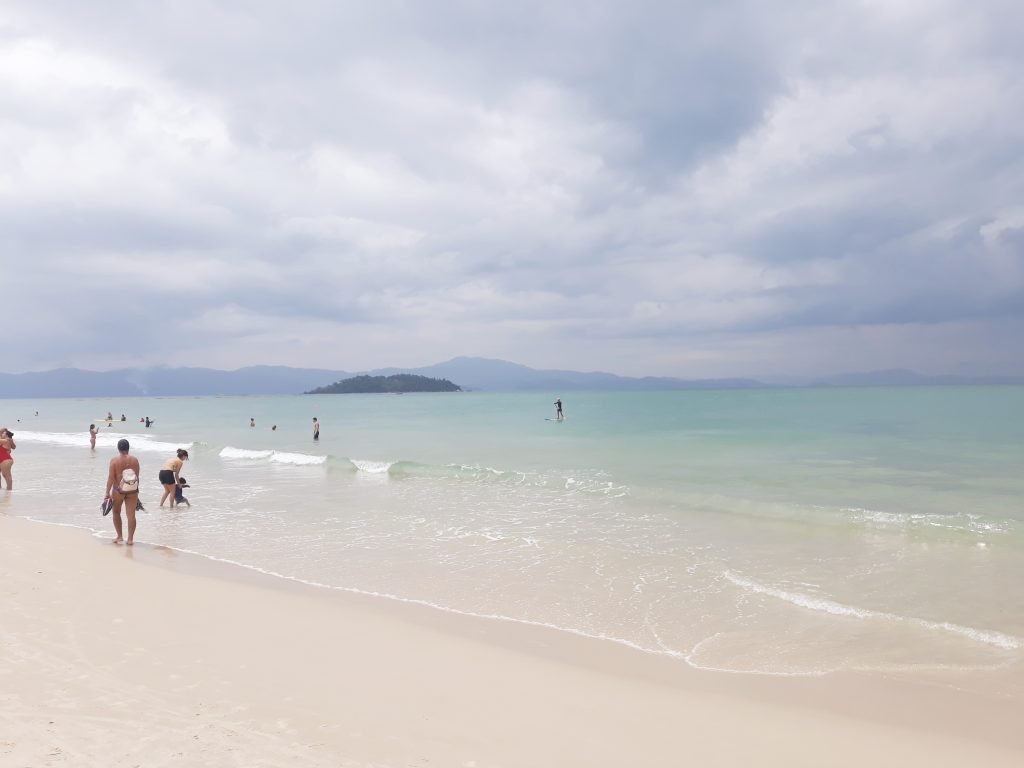Imagine escaping scorching 40°C summers and bone-chilling -10°C winters, while renting a central apartment for under €450, and enjoying good healthcare – all for a fraction of the costs.
The problem? These splendid, but underrated cities get overlooked—and yeah, that’s partly my fault. In my last ranking of the best cities in Europe, one criticism stood out: most of them get too hot during the summer.
Fair point.
So this time, we’re going cooler—literally. 28°C summers, mild winters, and still very affordable
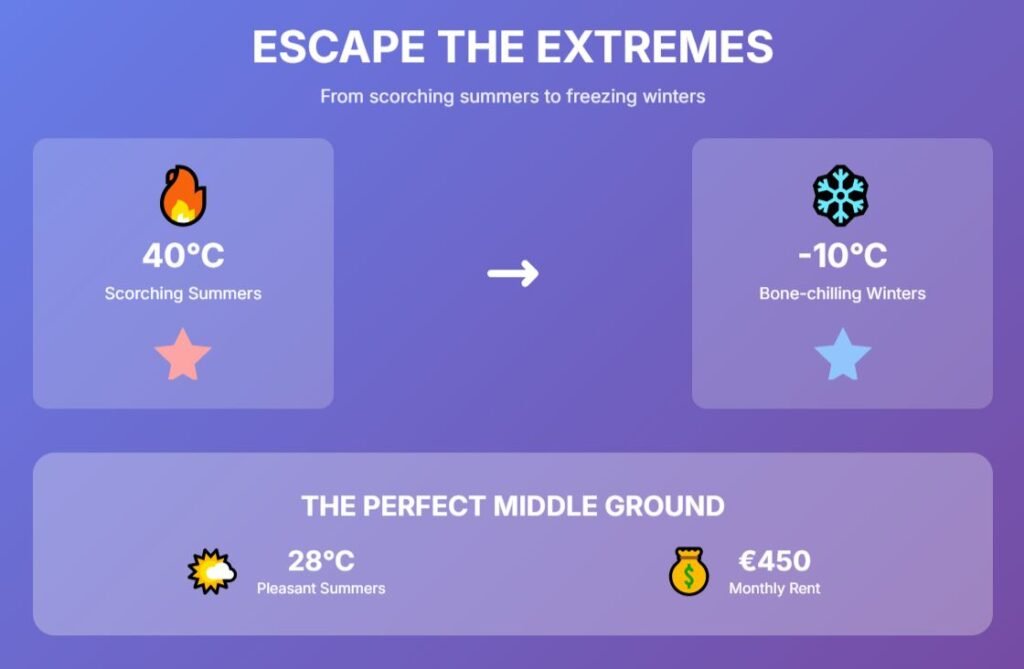
And here is another curious thing – most people assume you have to choose between good climate, low cost of living, or quality of life—but that’s not true.
Today I’m revealing 10 Not-So-Hot European cities that prove you can have it all – and some of these will surprise you because they’re places most expats completely ignore.
The Criteria to Rank the Best Not-So-Hot Cities in Europe
To narrow this list, I used clear and measurable filters.
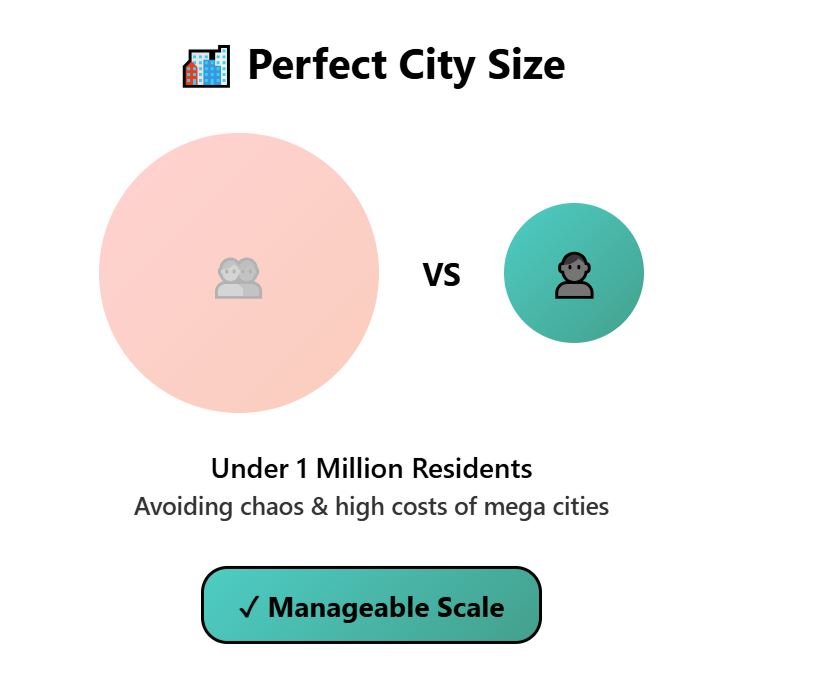
- Each city must have fewer than one million residents, so as to avoid the high costs and the chaos of very large cities.
- Summers should stay below 30°C on average, which rules out locations known for extreme heat.
- Winters must remain above freezing, because several popular destinations become harsh and impractical once temperatures drop too far.
- Another essential factor is cost: each city needs to be below the European Union’s average index, making sure affordability is real and not just a perception.
- Infrastructure, healthcare, and safety standards also weigh heavily, since they directly affect long-term livability.
When all these conditions stack together, the pool of options shrinks dramatically.
Many cities in Europe will meet two or three requirements, but very few pass every single one.
That’s what makes the following 12 cities unusual – they did well in most criteria.
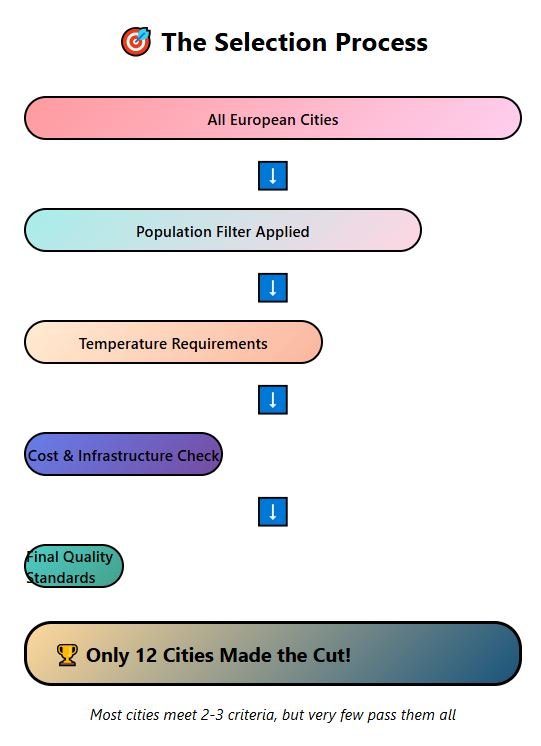
Let’s start on the Black Sea coast, with…
12 – Varna, Bulgaria

On the Black Sea coast, Varna, with 311,000 residents, combines affordable living with a climate that avoids extremes. Average summer highs stay around 28°C.
During winters, Varna experiences, on average, just 20 days of freezing temperatures. It might sound like a lot, but for comparison, Chicago, in the US, has more than 90 days of freezing temperatures per year!
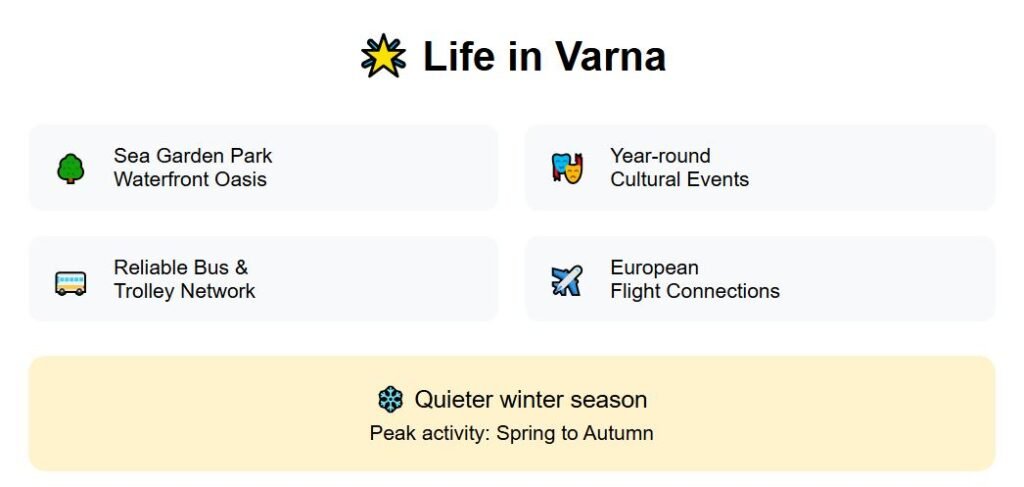
The climate score for Varna is a 6 out of 10. Housing is another strong point. A one-bedroom apartment in the center rents for about €450 per month. That’s significantly cheaper than Western Europe – by a LARGE margin.
Utilities and groceries also come in low, giving you a total living cost of less than €900 per month for a single person. The affordability score for Varna is a 9 out of 10.
The infrastructure is decent for a mid-sized city. The bus and trolley network connects the residential areas reliably to downtown. The airport also has flights to other European capitals, but the schedule is seasonal and many routes are cancelled during the low season. In terms of hospitals and healthcare, there are some decent private institutions with affordable prices. Infrastructure score: 6.0.
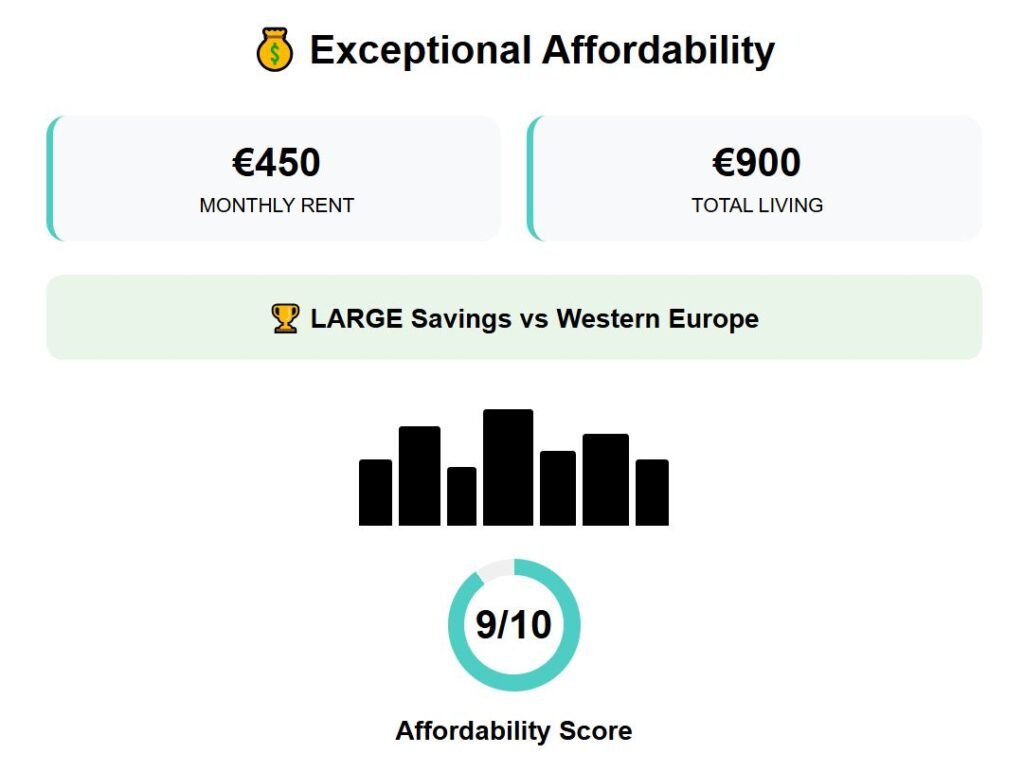
Quality of life has its ups and downs. On the plus side, the Sea Garden park stretches for kilometers right along the waterfront, providing a daily oasis few cities can match. Cultural events run year-round, and crime levels stay relatively low.
On the downside, there are problems with petty theft, especially in some areas, and locals reported that this is partially due to a certain part of the population, which I will not name- but you can guess in the comment section.

Another issue with Varna is that during winter, it slows down – this is what a resident told us:
“Varna goes into a bit of a hibernation during the winter, and there are considerably more events during late spring to early autumn.”
So, considering everything, Varna gets a quality of life score of 6

Add all these numbers together, and Varna lands a total score of 27 – we will give a specific score to each city in our ranking, because here we REALLY like numbers.
From the Black Sea coast, let’s now look to the Atlantic side of France.
11 – Brest, France
On the far western tip of France, Brest sits on the Atlantic coast with a population of about 140,000. The city’s climate is oceanic, meaning summers remain cool and winters are wet, but it rarely experiences days below freezing. Even in August, average highs stay around 22–26°C, keeping conditions moderate through the year.
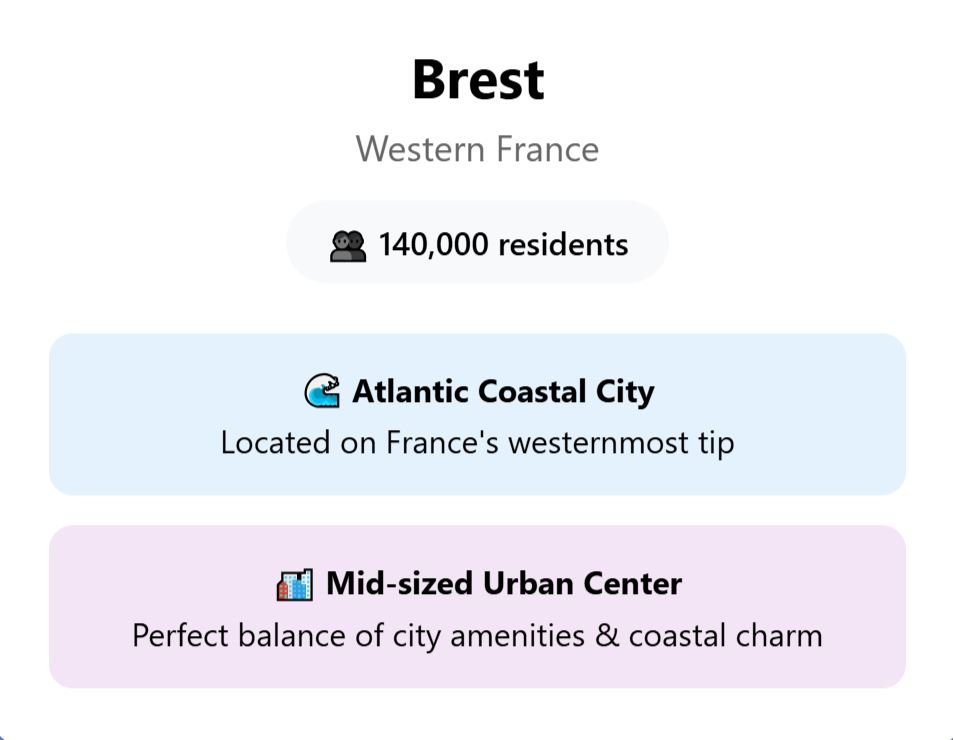
A local described the weather in Brest for us:
“Brest is a coastal town and has its own micro-climate that is notorious for being grey and rainy all the time. While this might be an exaggeration, it does take root in reality. Expect grey most of the year and a lot of thin rain. Although that can be seen as a negative point, it does have its benefits as it’s often spared from massive heat waves during the summer, making it a true moderate climate.”
Climate score: 7 out of 10 – I hope you don’t mind some rain.
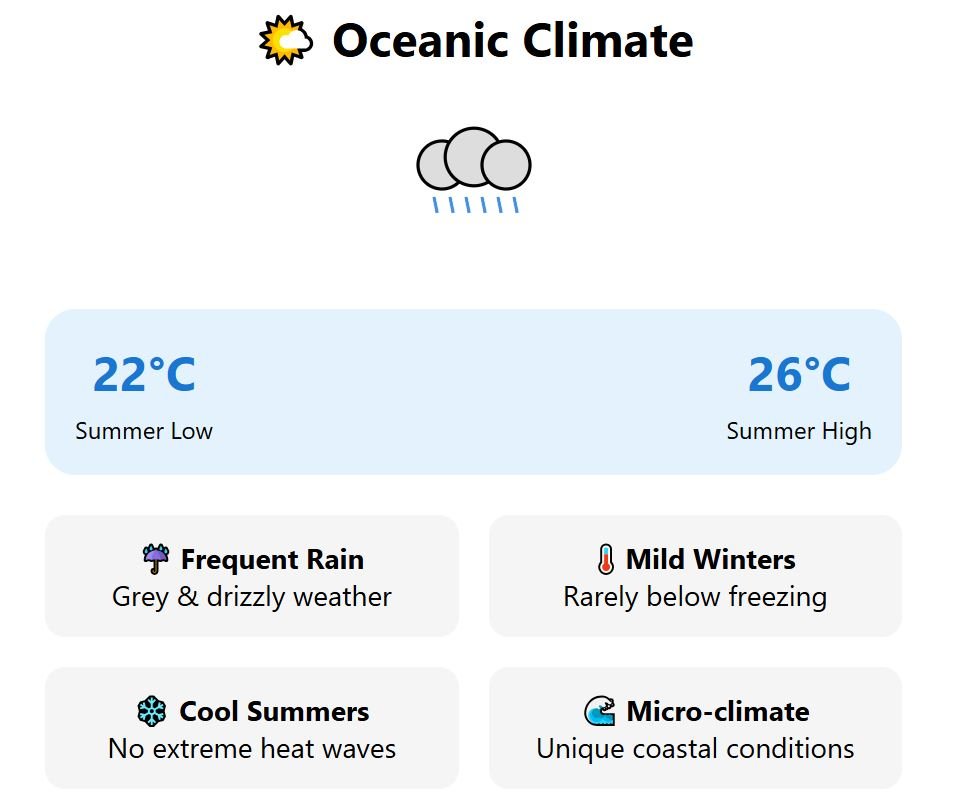
When it comes to cost, Brest is not as cheap as most of the cities in this ranking. Renting a one-bedroom apartment in the center costs about €770 per month. Food and basic goods also run higher than the EU average, lifting the overall expenses. On the other hand, services are consistent with French standards. For affordability, Brest reaches a score of 5 out of 10.
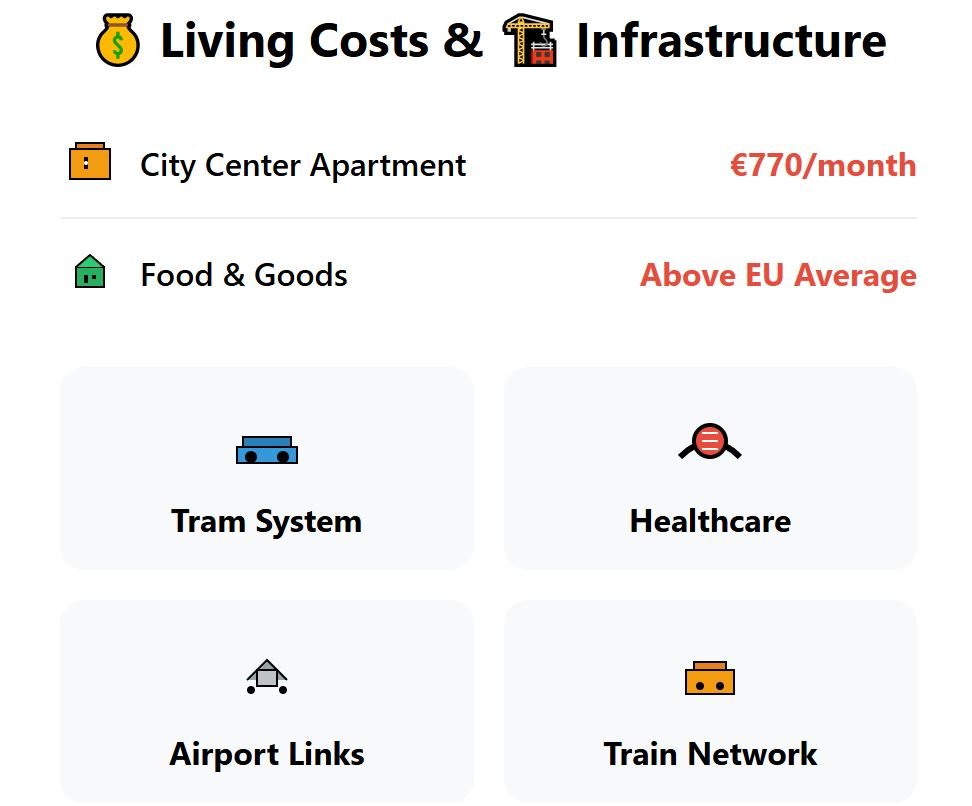
Infrastructure is where the city performs strongly. Brest has a tram system, expanding bus routes, and an airport that connects to Paris and other major hubs, though not with the frequency of larger airports. Trains and regional links also add to mobility. Healthcare standards are high, with public hospitals and access to private clinics as an option for faster services. Infrastructure score: 8 out of 10.
Quality of life stays elevated due to safety, greenery, and coastal scenery. Brest has the urban comfort of a mid-sized city with cultural activities and outdoor options. Crime levels stay low, though the weather’s dampness can feel limiting. Quality of life score: 8 out of 10.
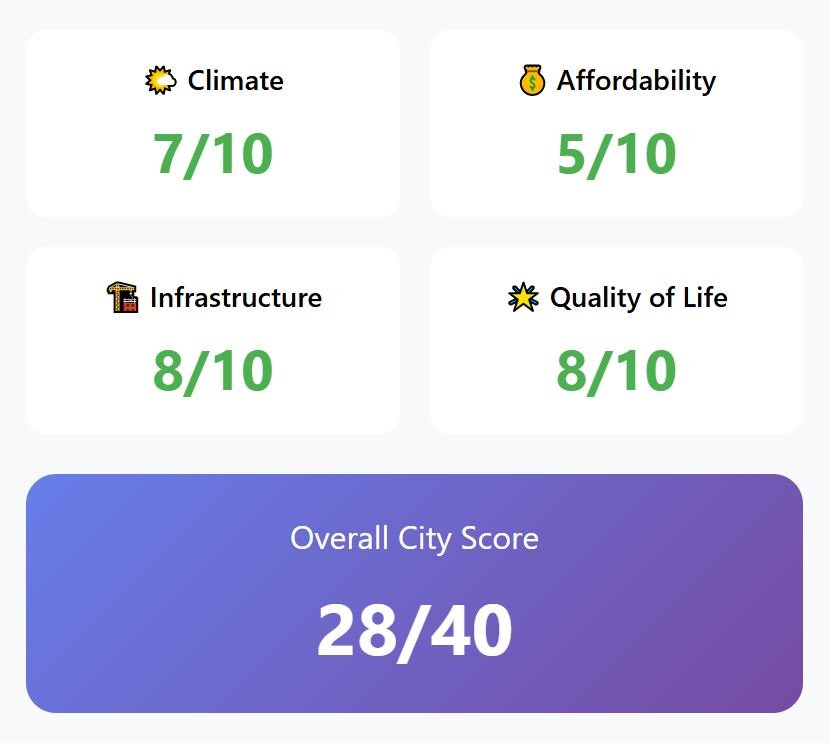
Combined, Brest records a total score of 28. Heading inland, the next stop is Slovakia’s capital, where affordability balances better with city living.
10 – Bratislava, Slovakia
The capital of Slovakia is right on the Danube River with fewer than 450,000 residents. Its climate is continental, so summers average around 27°C, and winters bring snow but remain moderate compared to colder Northern regions.
You will still see frosty mornings, but the season is short and predictable – climate score: 6 out of 10.
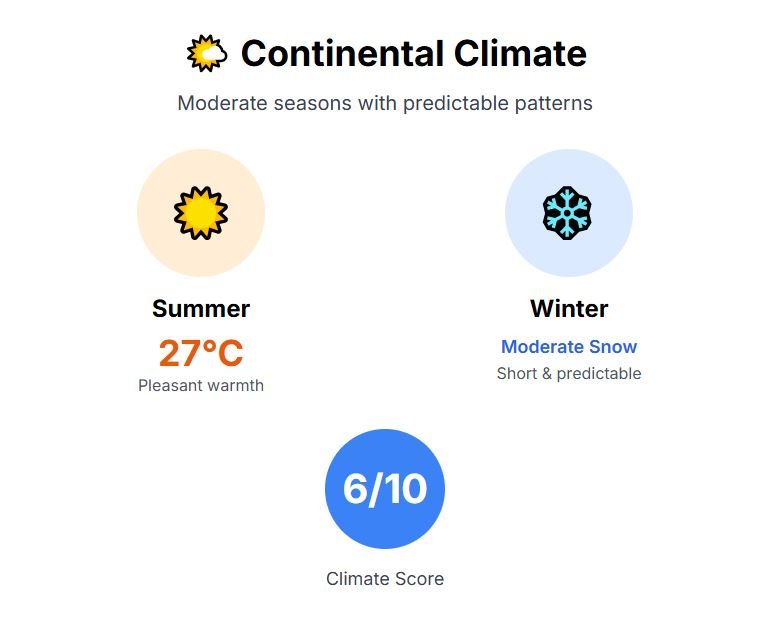
The cost profile is one of Bratislava’s advantages. A one-bedroom apartment in the city center rents for about €620. Groceries and daily services are lower than in Western European cities, which helps stretch your budget further. Cost score: 8 out of 10. ,
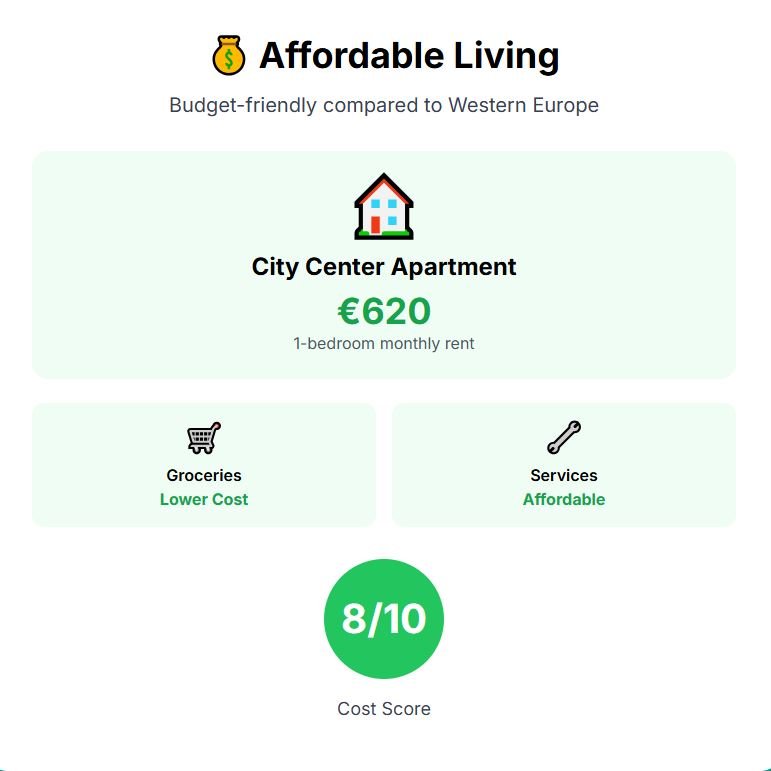
Infrastructure has mixed results. Public buses and trams connect the compact city easily, and Vienna’s international airport is only 45 minutes away by highway or train, giving access to the wider European network. Bratislava’s own airport offers low-cost flights across the continent. Healthcare is under reform, with €327 million invested to modernize major hospitals and improve care standards. Still, Bratislava is so close to Vienna, that if any need arises, you can just take a quick train. For such a privileged location, the infrastructure score is an 8 out of 10.
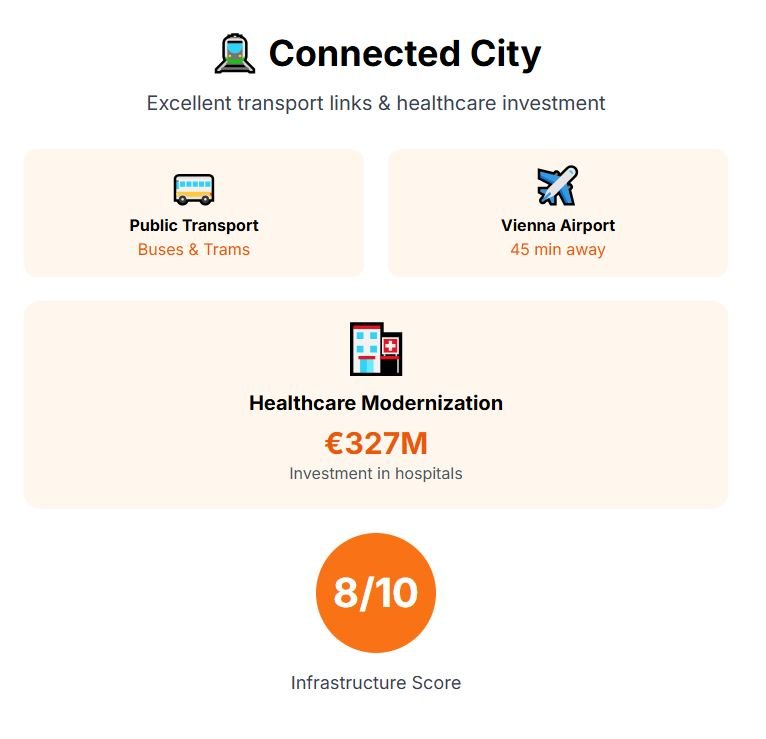
Quality of life combines good service options, safety, and manageable size. As a small capital, Bratislava offers theatres, museums, and a growing gastronomical scene without the pace of a megacity. Green areas along the Danube add outdoor value, and overall crime levels stay relatively low. The main downside is bureaucracy, which can frustrate newcomers. Quality of life score: 7 out of 10.
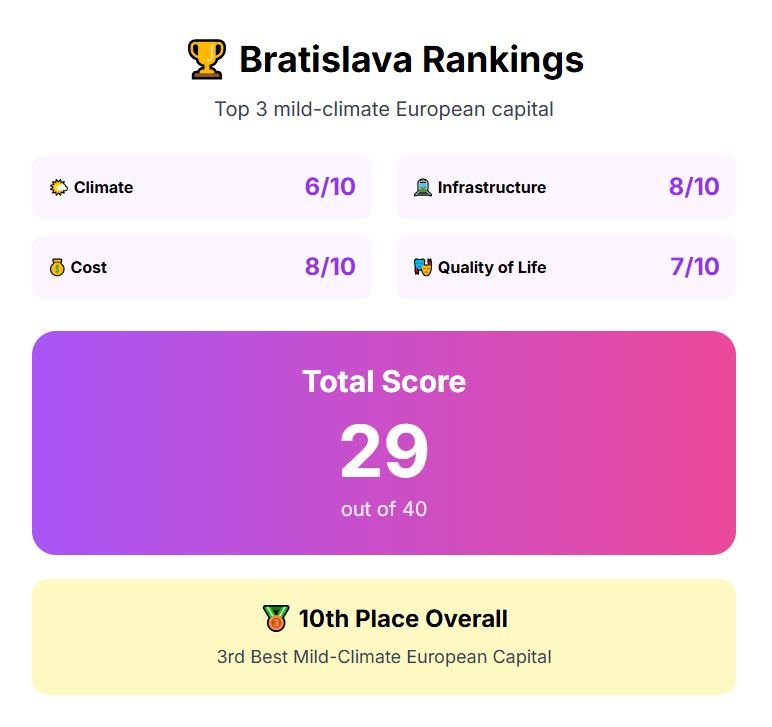
In total, Bratislava reaches a balanced score of 29 – It gives Bratislava the 10th place, but since in this ranking there are only 2 other capitals, we can safely say that Bratislava is one of the 3 best mid-sized capitals of Europe.
I was thinking about writing another article just ranking the European capitals – you would like such article, let me know in the comment section.
Next, a city that is just in a neighboring country of Slovakia, but it is NOT Vienna.
9 – Brno, Czech Republic
Brno, in the southeast of the Czech Republic, is the country’s second-largest city with about 380,000 residents. Its climate reflects a continental pattern, with warm summers that average 24°C and winters that bring some snowfall. The temperature swings are noticeable, but rarely reach extremes, since Brno is not a high-altitude city and it is in a lower elevation than Prague, for example. Brno gets a climate score of 6 out of 10.
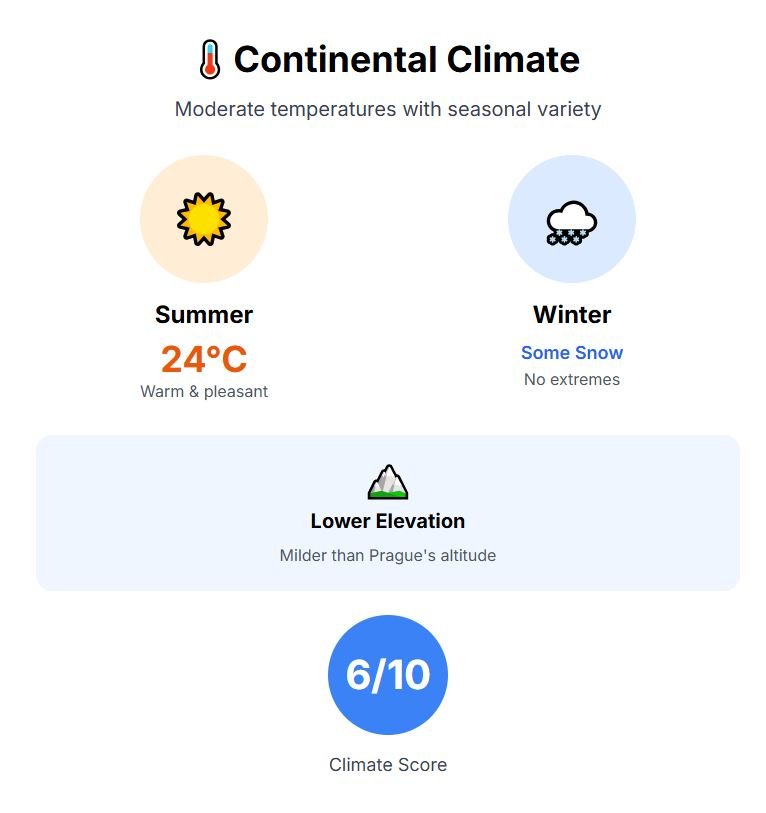
Costs are a significant draw. A central one-bedroom apartment averages €720 monthly, while daily living expenses are generally 25 to 30 percent lower than in cities in Western Europe. This means a comfortable lifestyle is attainable for both locals and foreigners. Brno’s cost score is a solid 7 out of 10.
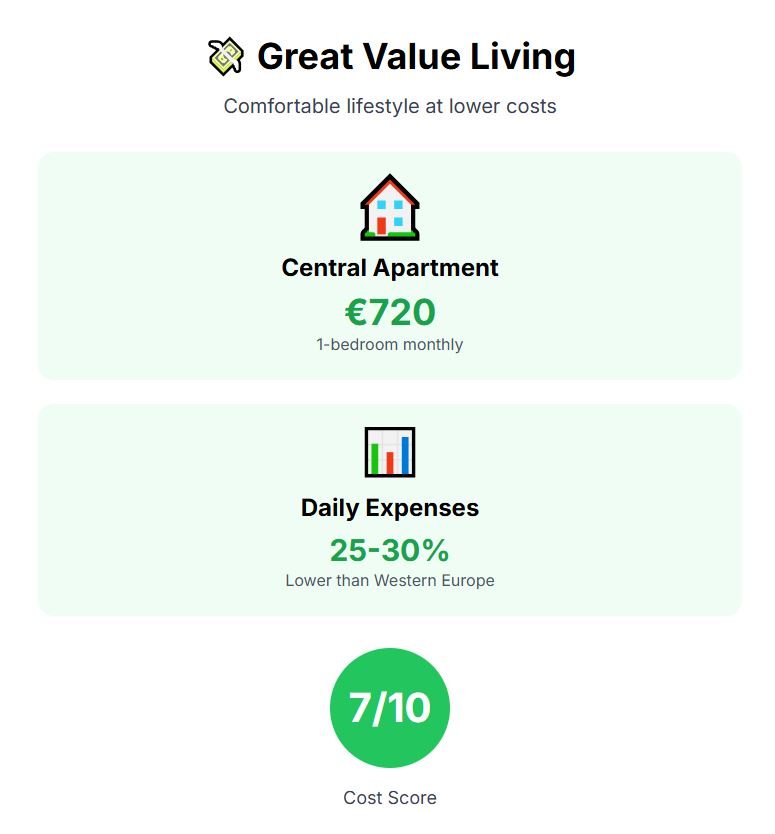
Infrastructure is one of the city’s strengths. The tram and bus network reaches virtually every neighborhood and is known for its punctuality. Brno’s airport offers short-distance connections, but easy rail links to Vienna and Prague expand travel options significantly. Healthcare access is consistent, with both public and private facilities available, although regional inequalities remain. For infrastructure, Brno earns 8 out of 10.
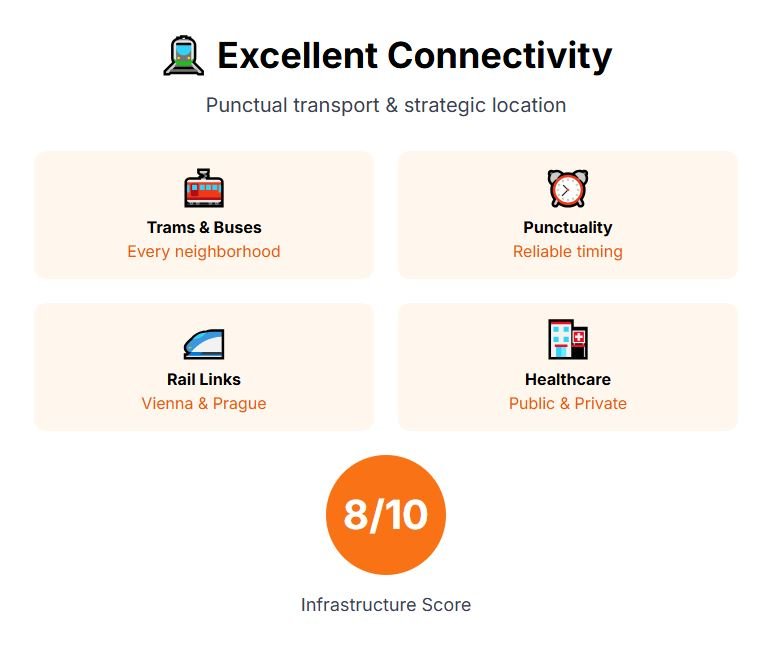
Quality of life combines safety, education centers, and cultural activity. Universities keep the city young and active, with crime levels staying relatively low compared to larger cities. The downside is the lengthy winters, which some may find limiting, but daily services and stability outweigh the cold. Quality of life score: 8 out of 10.
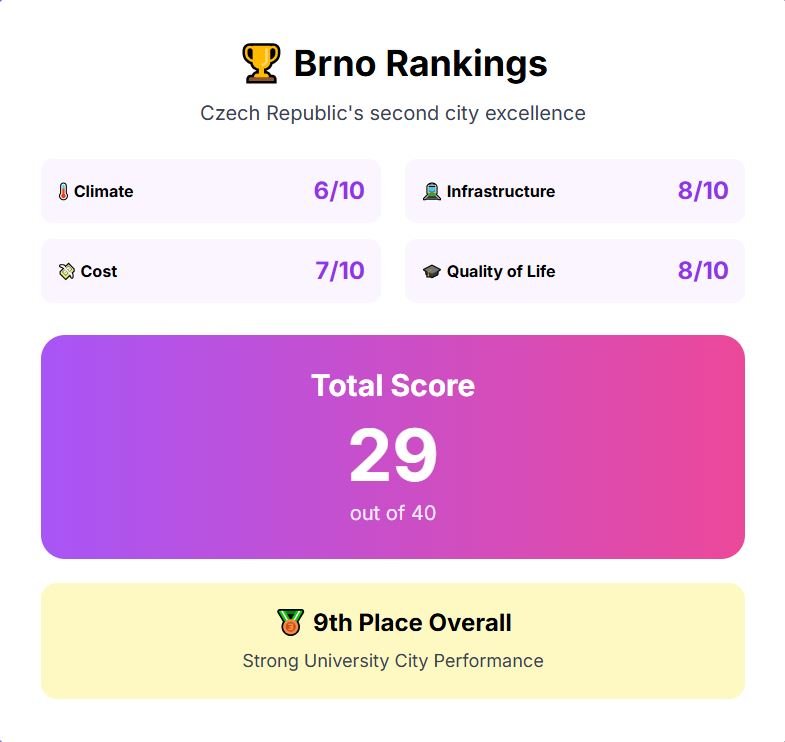
Altogether, Brno marks a total score of 29. From here, we head to a rainy northern city that developed considerably during the last few decades.
8 – Bilbao, Spain
Bilbao is in northern Spain’s Basque Country with a population of around 340,000 in the city and nearly a million in the metro area. Known for its compact layout, 99.8% of residents live within walking distance of a bus stop, which already says a lot about how easy daily mobility is. The climate is oceanic, so summers average 25°C and winters rarely dip below 6°C. The downside is rainfall, with close to 120 wet days a year, which makes it less appealing for sun seekers. Climate score: 7 out of 10.
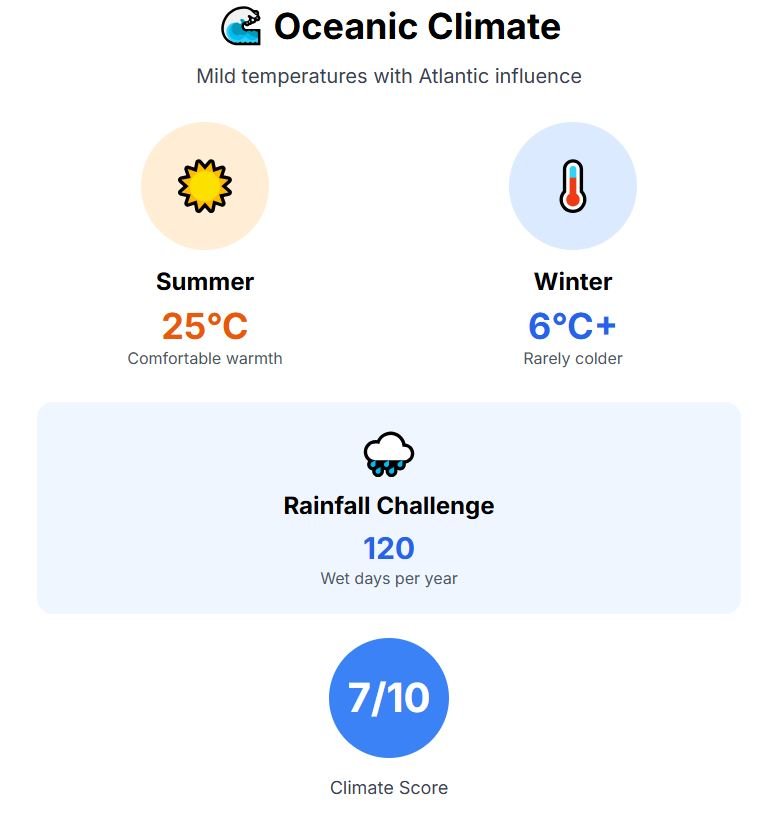
Living costs in Bilbao fall between €1,200 and €1,500 per month for a single person, which is higher than many of the cities in this ranking, but moderate compared to other Western cities. Central rents average €850 for a one-bedroom, and public transport passes cost only €35–45 monthly, helping offset high food and service prices. Cost of living score: 6 out of 10.
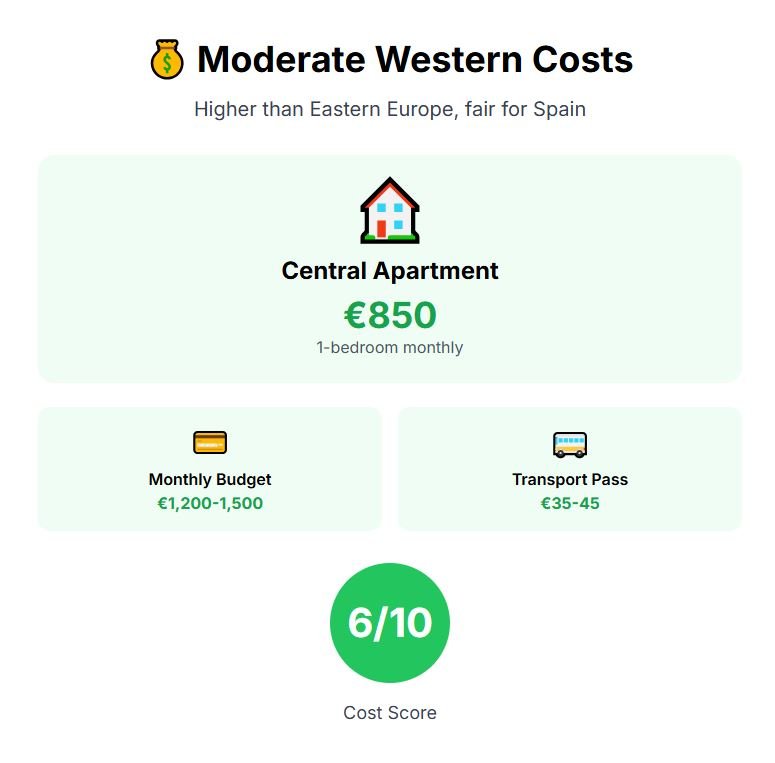
Infrastructure is Bilbao’s strongest point. Its metro and bus systems are extensive, the airport connects directly to top European hubs, and healthcare ranks well with both public facilities and private clinics. The city also enforces a 30 km/h speed limit that reduces accidents and pollution. Infrastructure score: 9 out of 10.
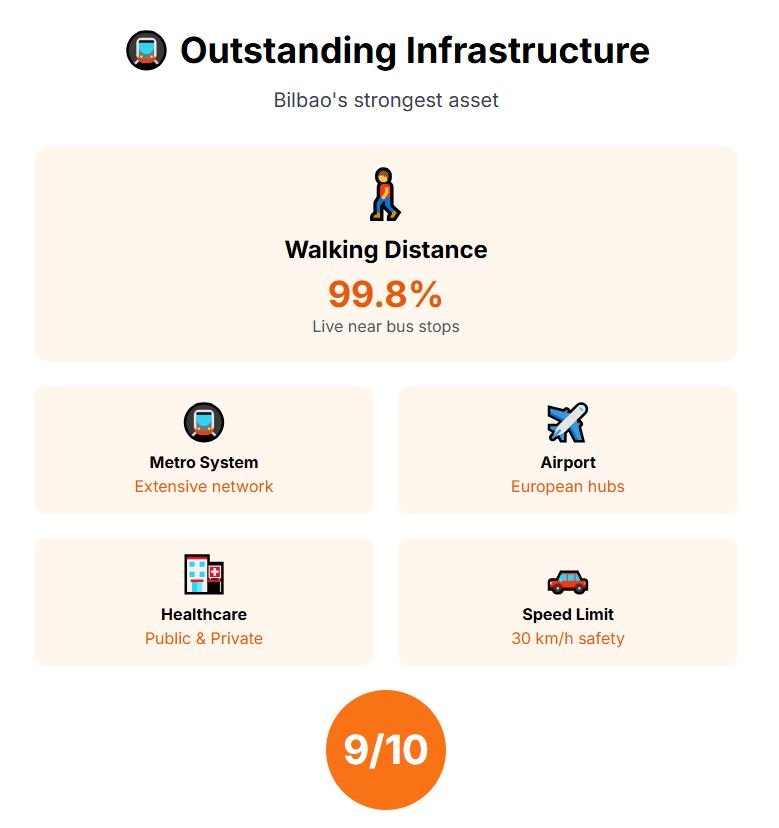
Quality of life benefits include low crime, a strong food culture, and plenty of green spaces. The rain is the main complaint, but many consider it a fair trade for safety and stability. Quality of life score: 8 out of 10.
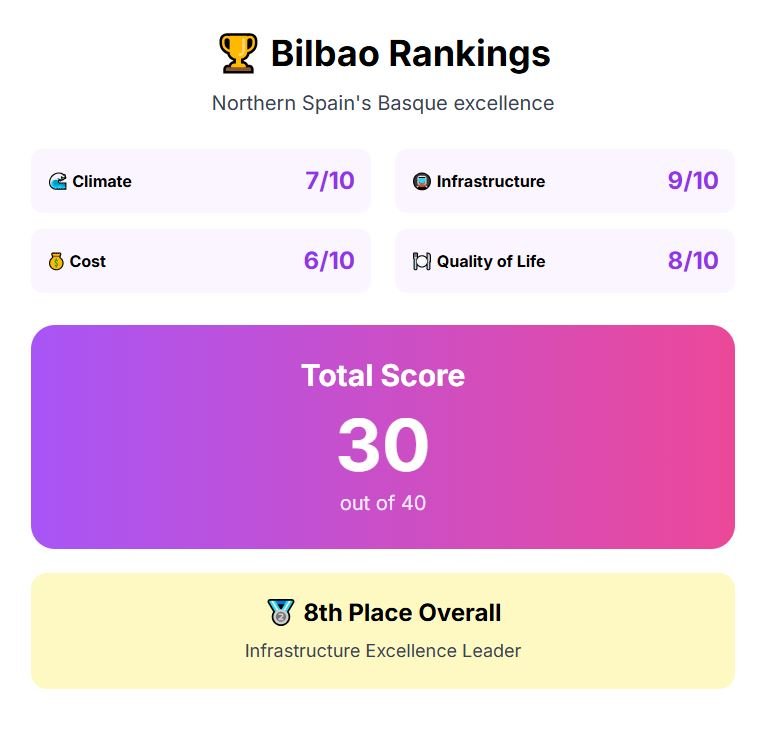
Bilbao totals 30 points. From Northern Spain’s drizzle, we turn to sunny wine country, in France.
But before, I have some really good news. FREE FOR A LIMITED TIME: Grab your Expat Wealth & Lifestyle Compass ($108 value) today! Includes our 74-page guide of Affordable European Cities, our Zero-Tax countries report, and our expat checklist. Join us here before this offer ends.
7 – Bordeaux, France
Bordeaux, in southwestern France, has about 260,000 residents in the city proper and nearly 1 million in the metro area. Its climate is mild and fairly sunny, with around 2,000 hours of sun each year. Summers hover near 27°C while winters stay cool but rarely severe. For a European city at this latitude, that balance makes outdoor life pleasant much of the time. Climate score: 8 out of 10.
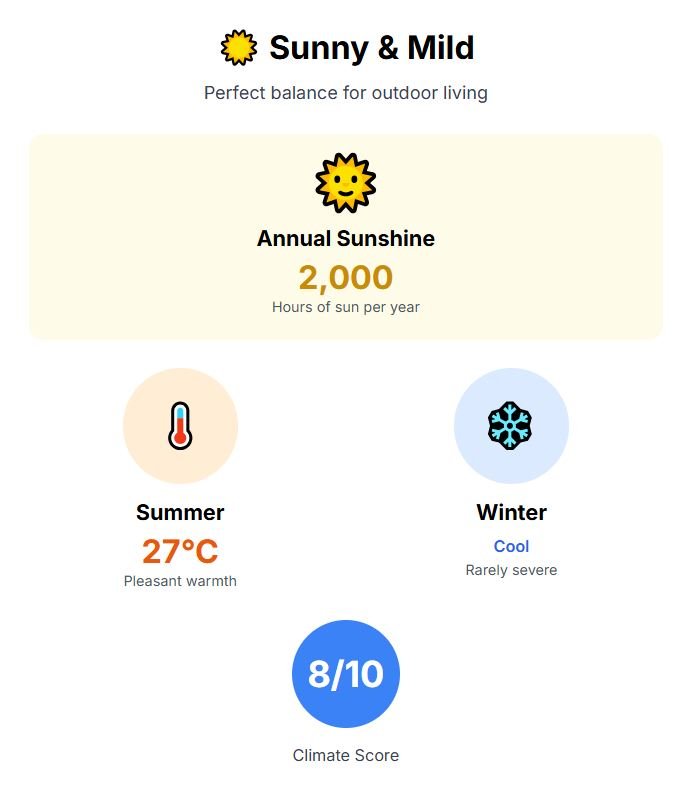
Living in Bordeaux comes with higher costs. A one-bedroom apartment in the city center averages €774 per month, and other everyday expenses like groceries and dining follow the Western European norm. For many households, this means a tighter budget than in cities to the east. Cost score: 5 out of 10.
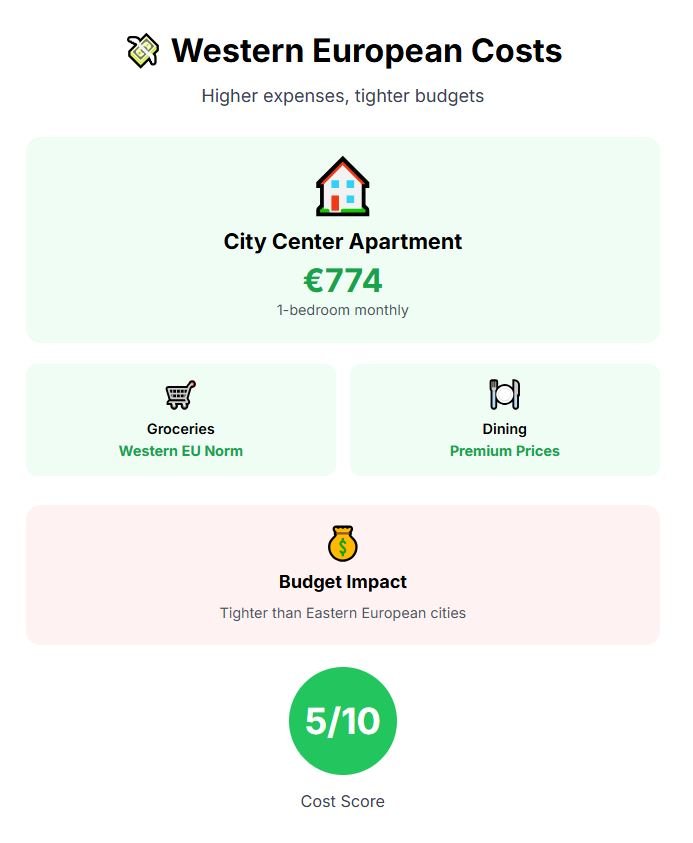
Infrastructure is where Bordeaux invests heavily. In recent years, public transport expanded by 13 percent, and the city now operates a multimodal app tying together trams, buses, and bikes to meet sustainability goals. The local airport has direct flights to other European capitals, and healthcare here reaches full French standards, combining high-quality public hospitals with optional private clinics. Infrastructure score: 9 out of 10.
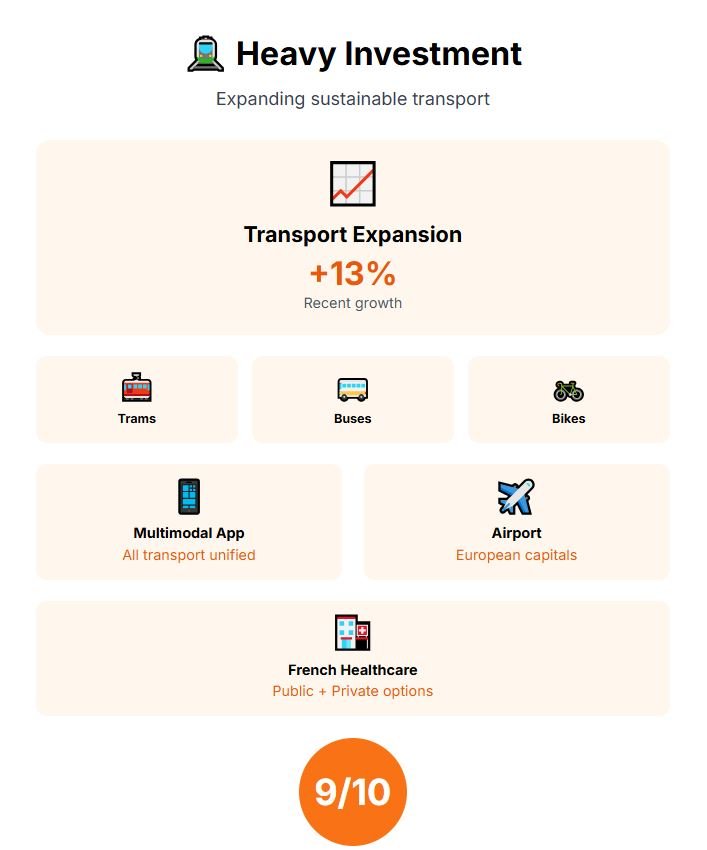
Quality of life also ranks high. The city has abundant green spaces, a strong safety record, and cultural amenities connected to its wine region identity. Think of it like living in California’s wine country, but with French healthcare included at standard rates. Quality of life score: 8 out of 10.
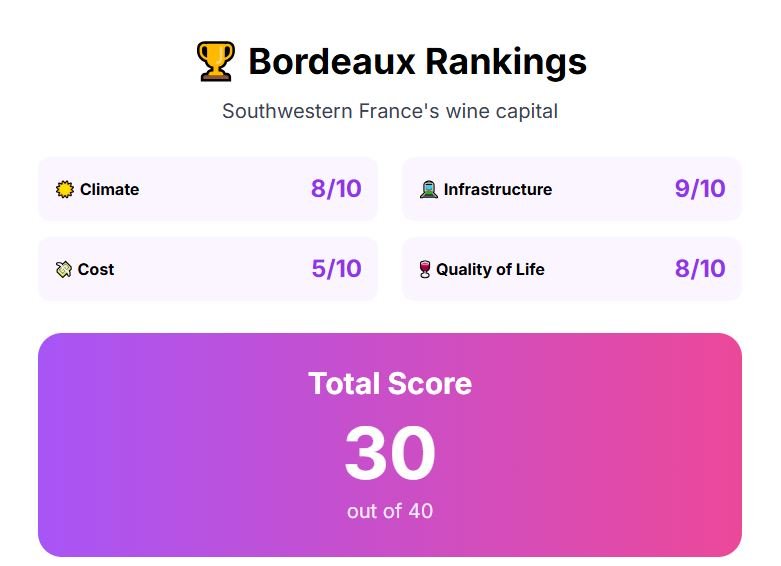
Altogether, Bordeaux earns 30 points. From French vineyards, we now move toward Croatian affordability.
6 – Zagreb, Croatia
The Croatian capital is located inland, with a population of roughly 800,000 people, making it large enough to have full services yet still smaller than Western European capitals.
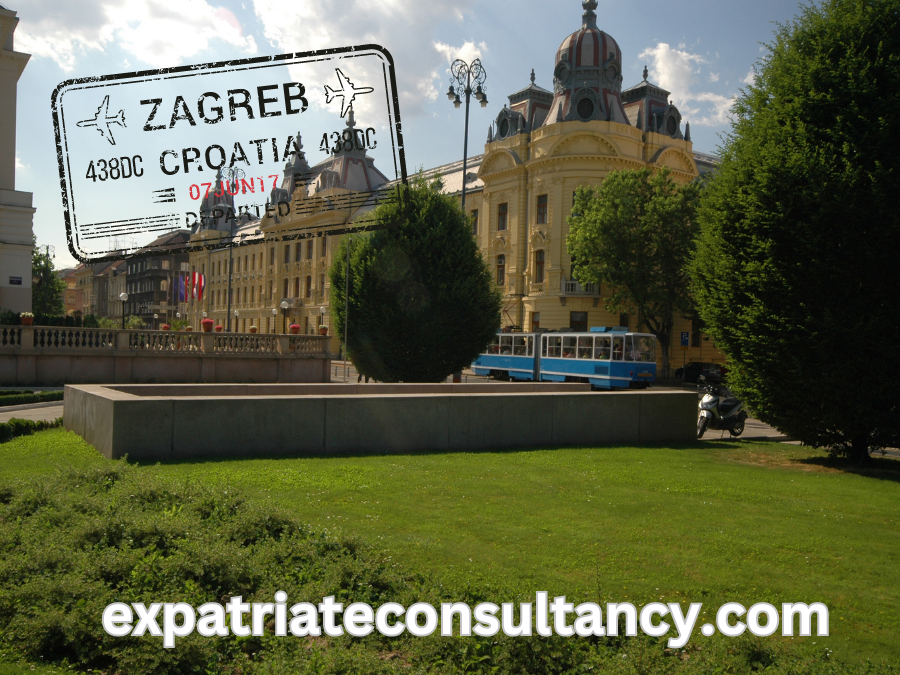
Summers are warm, sometimes reaching 30°C in July, but not scorching like in Sicily, while winters are snowy but not overly severe, averaging just below freezing for a short time. So the key here is that sometimes Zagreb might be hot or cold, but not for long. For climate balance, Zagreb earns a score of 7 out of 10.
Costs remain reasonable by European standards. A one-bedroom apartment in the center rents for about €654 monthly, with overall living costs comfortably lower than cities in France, Germany, or Italy. Cost of living score: 8 out of 10.
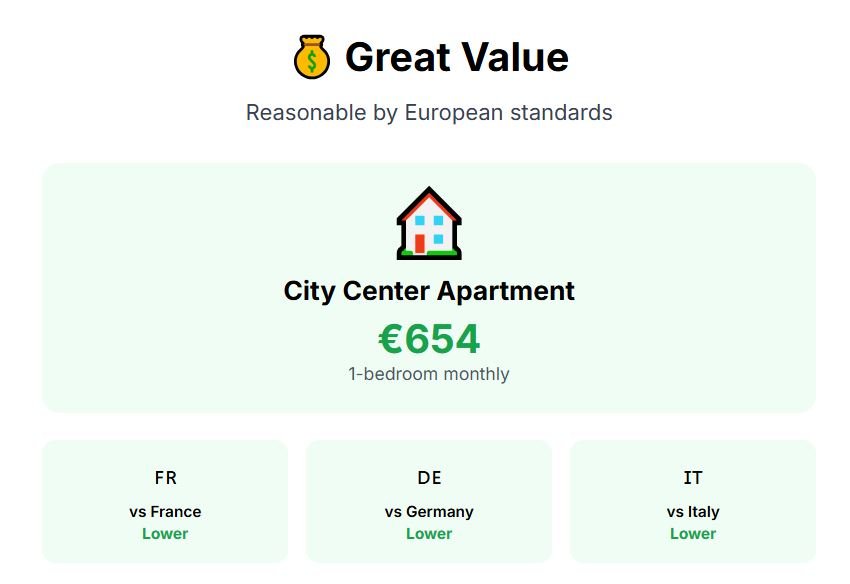
Infrastructure is mixed. Zagreb relies heavily on its tram-and-bus network, which forms the city’s backbone. Efforts are underway to electrify fleets, and smart cycling initiatives are being introduced, paving the way for greener transport. The airport connects to other European capitals with direct routes. Healthcare coverage is universal, but the main drawback is long waiting times in the public system. Good private healthcare options are available – Infrastructure score: 8 out of 10.
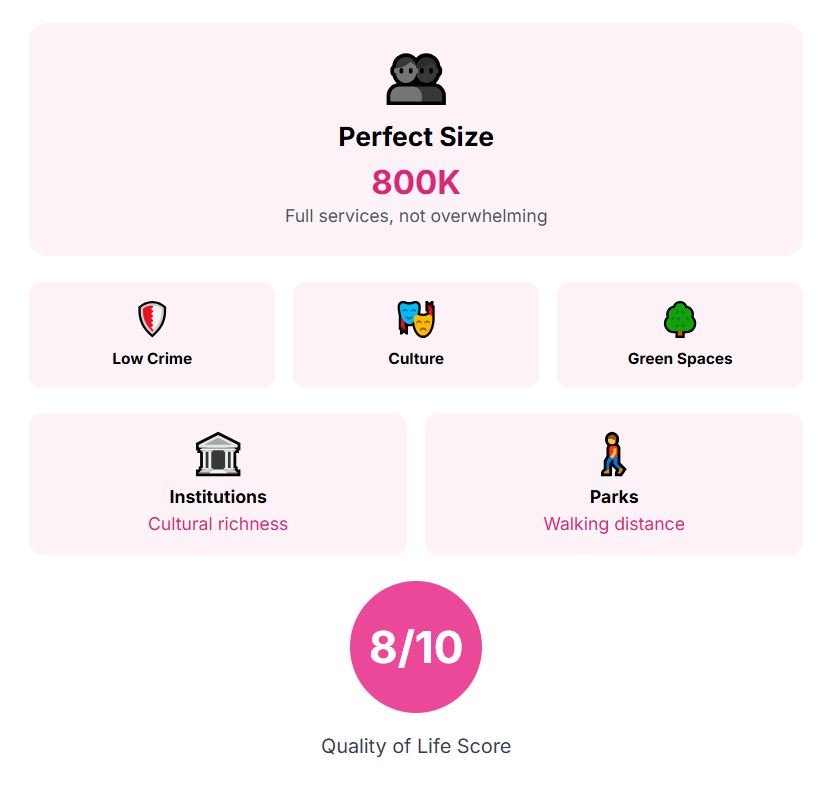
In terms of quality of life, Zagreb performs well. Low crime, cultural institutions, and green spaces spread across the city provide security and recreational value. Parks are abundant within walking distance in most neighborhoods. Quality of life score: 8 out of 10.
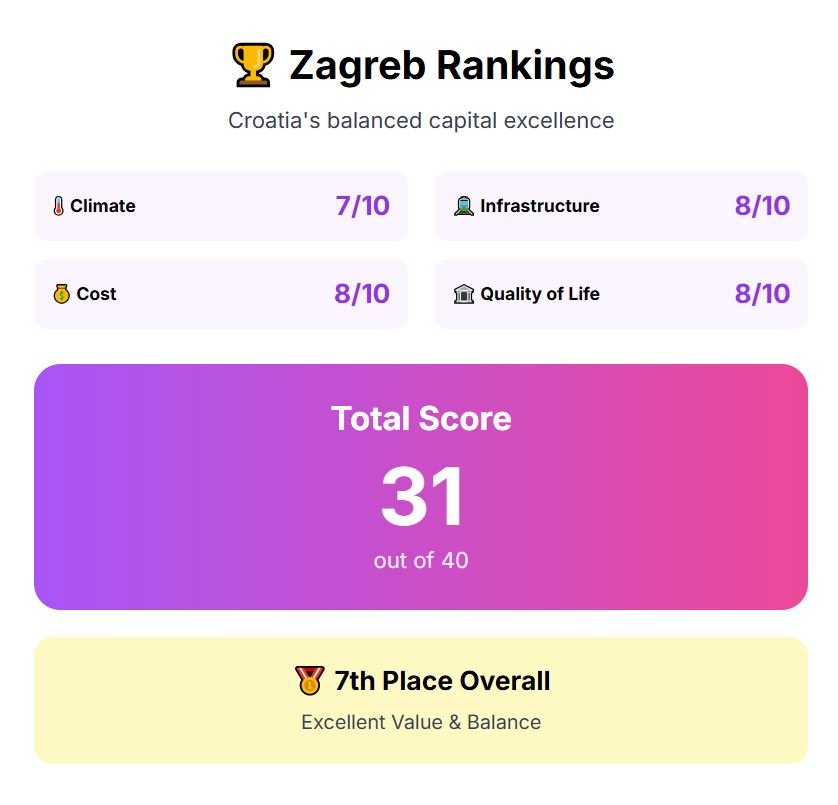
Taken together, Zagreb achieves a total score of 31. Now let’s cross the Adriatic sea, where a coastal city that you might never heard about before, is a good surprise.
5 – Trieste, Italy
Trieste is in northeastern Italy, right on the Adriatic Sea, with a population of about 200,000 people. Its coastal position gives it warmer, but not too hot, summers, with highs around 28°C, and colder winters compared to Italy’s interior cities.
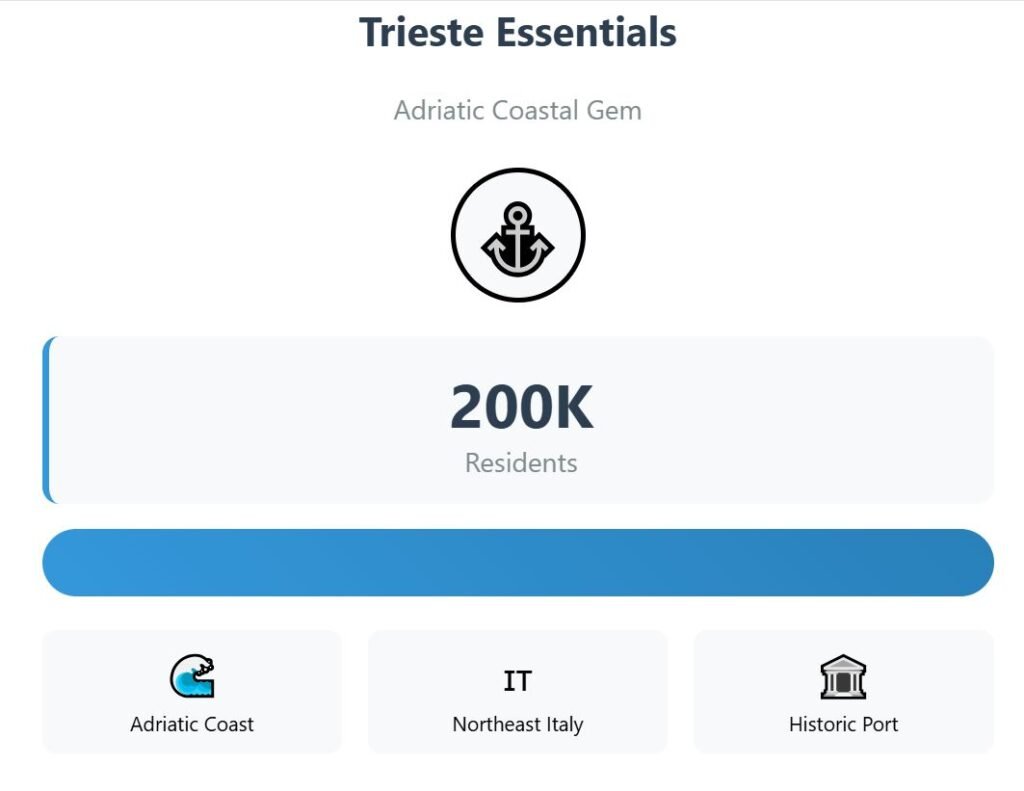
What makes it distinct is the Bora wind, a strong gust that sweeps through during winter, lowering temperatures and making the cold feel colder – but it is not that frequent, it is more like a curious, unexpected phenomenon. Climate score: 7 out of 10.
Living costs there are what you would expect from a mid-sized city in Western Europe. Renting a one-bedroom apartment in the city center averages €710. This is a decent value for such a premium location in Northern Italy, which is one of the richest areas in Europe by the way. The Cost of living score for Trieste is a 7 out of 10.
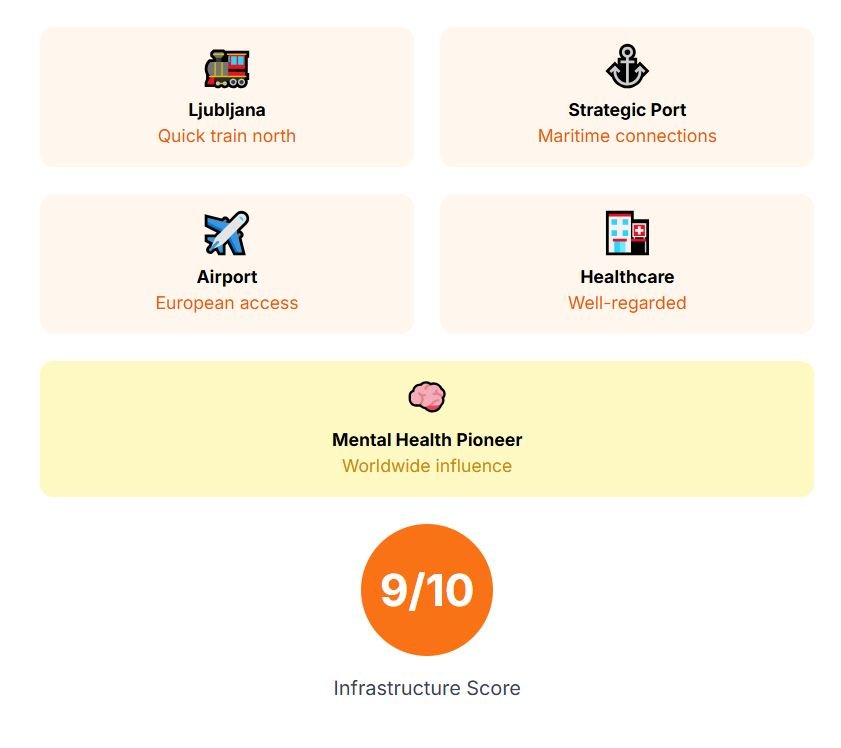
Infrastructure is even better. A tram and bus network serves the city, and the proximity to Ljubljana allows quick train travel north for cross-border commuting. Trieste’s port also provides strategic connections, while the airport ensures access to wider Europe, though with fewer routes than major hubs. Healthcare services here are well-regarded, and notably, the city pioneered a mental health system that remains influential worldwide. Infrastructure score: 9 out of 10.
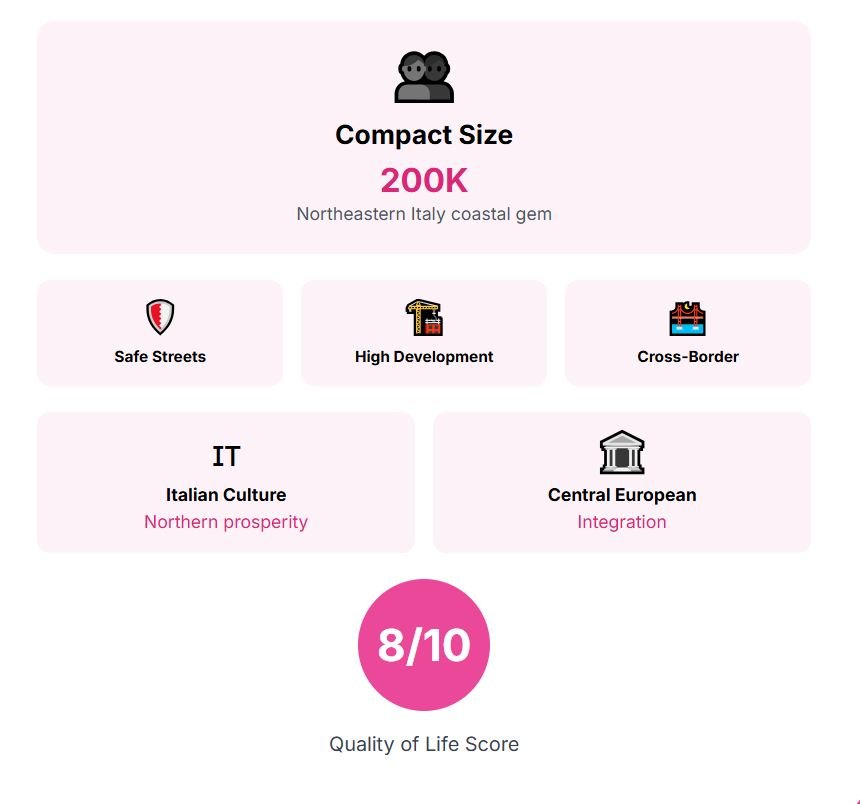
Quality of life benefits from safe streets, the high level of development of northern Italy, and integration between Italian and Central European cities. Quality of life score: 8 out of 10.
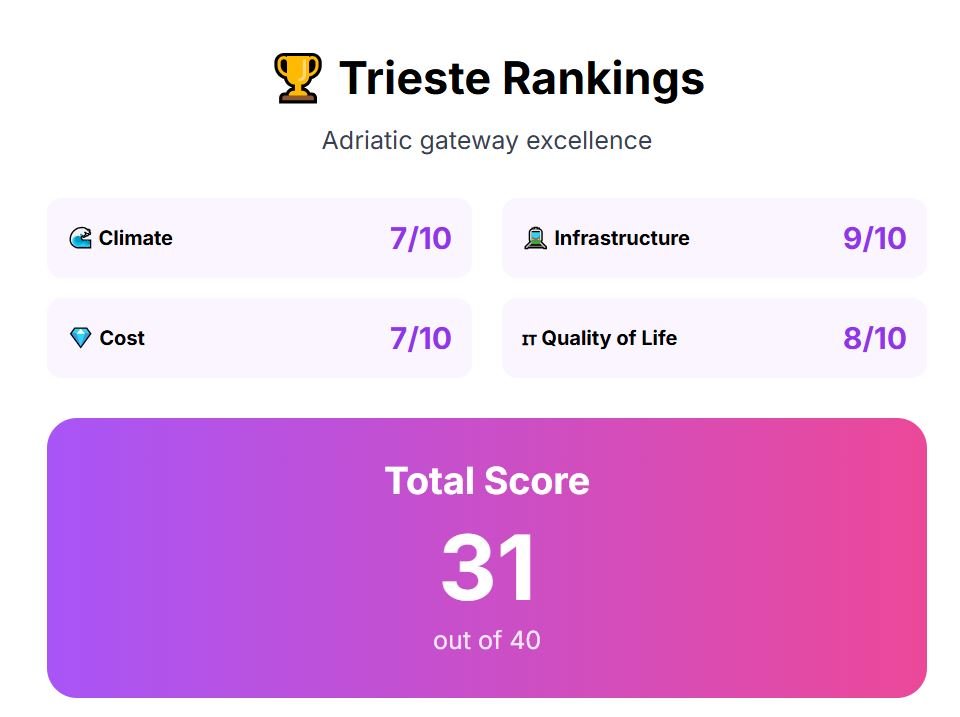
Together, Trieste totals 31 points. Next, Romania’s most exciting rising city steps into the spotlight.
4 – Cluj-Napoca, Romania
Cluj-Napoca is Romania’s main city in Transylvania, with a population of about 286,000. It is widely called the country’s tech and startup hub, attracting IT firms and new businesses.
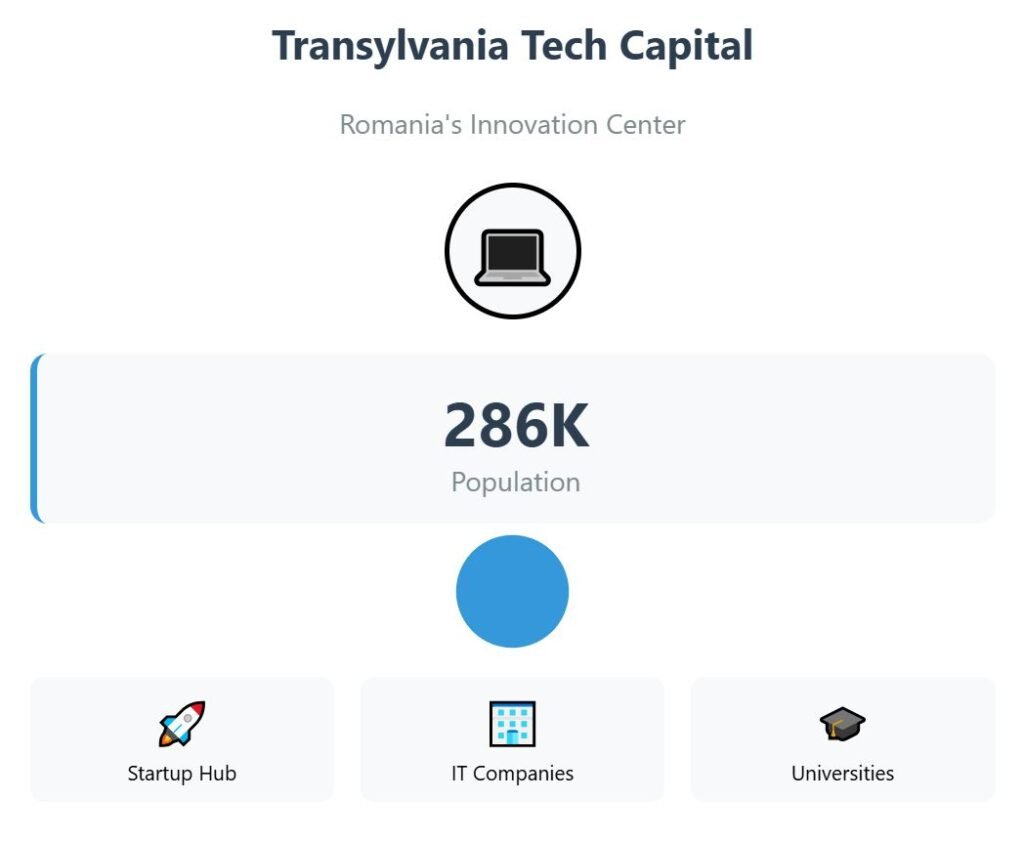
The climate is continental, so summers are warm and pleasant, with highs near 26°C, while winters have some freezing days below zero and a bit of snow. It offers clear seasons, a beautiful spring and autumn, but some cold days. Climate score: 6 out of 10.
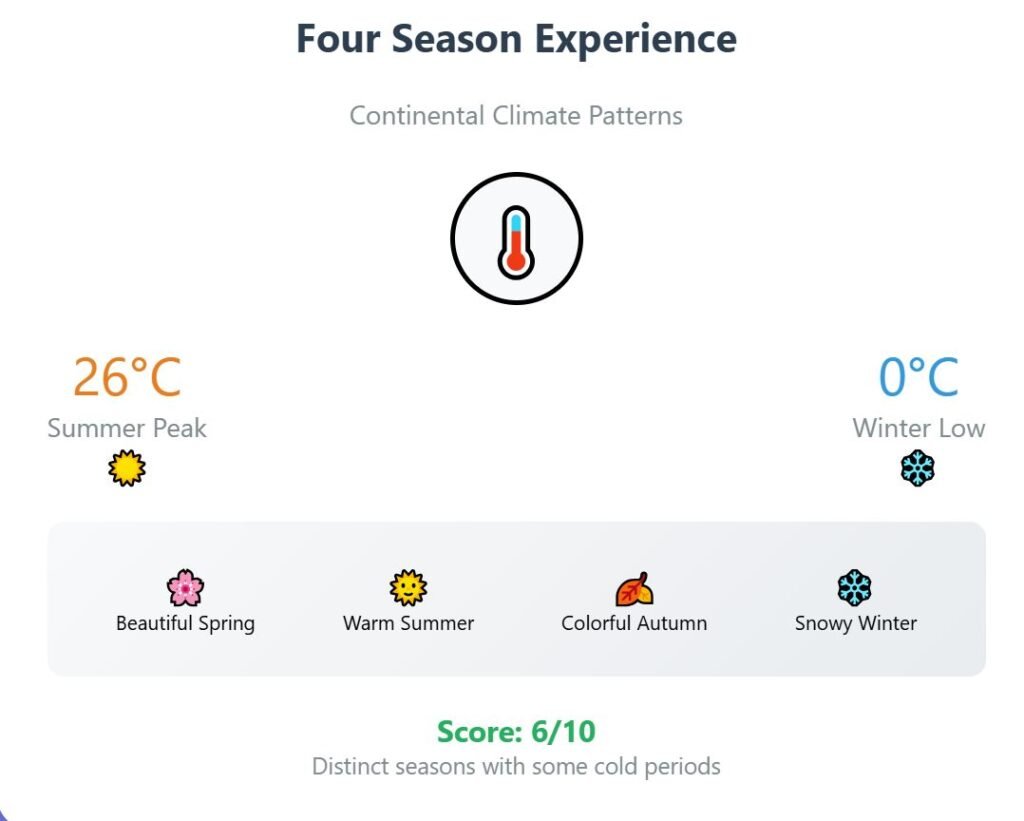
Costs there are higher than the Romanian average, but still modest compared to the West. The average rent for a one-bedroom flat in the center is about €545, and other items like groceries and entertainment are also quite affordable. That gives Cluj-Napoca a cost-of-living score of 9 out of 10.
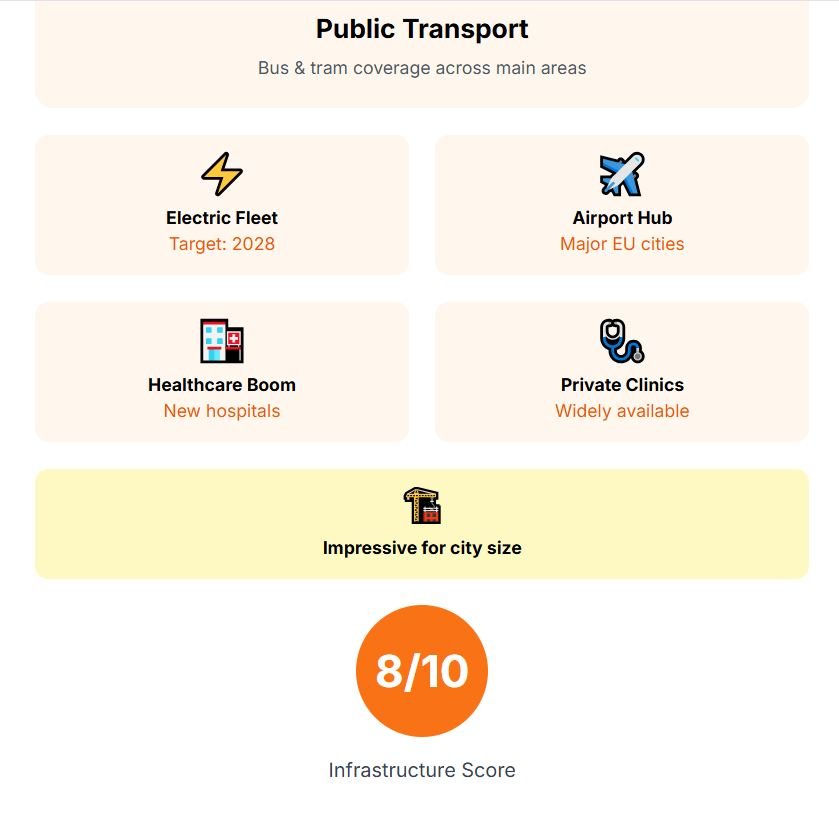
The infrastructure there has improved drastically – you can even say that Cluj today is a completely different city when compared to 20 years ago. The bus and tram lines cover the main parts of the city, and projects aim for a full electric bus fleet by 2028. The airport connects directly to multiple major European cities with regular flights. Healthcare also improved greatly, with new hospitals and expansions being built, and private clinics are also widely present. The infrastructure is impressive for a city of such size, so Cluj gets an 8 out of 10.
Quality of life benefits are high. Safety levels are good, crime is low, and parks and green zones are part of city planning. Universities bring cultural life and a young crowd. Quality of life score: 8 out of 10.
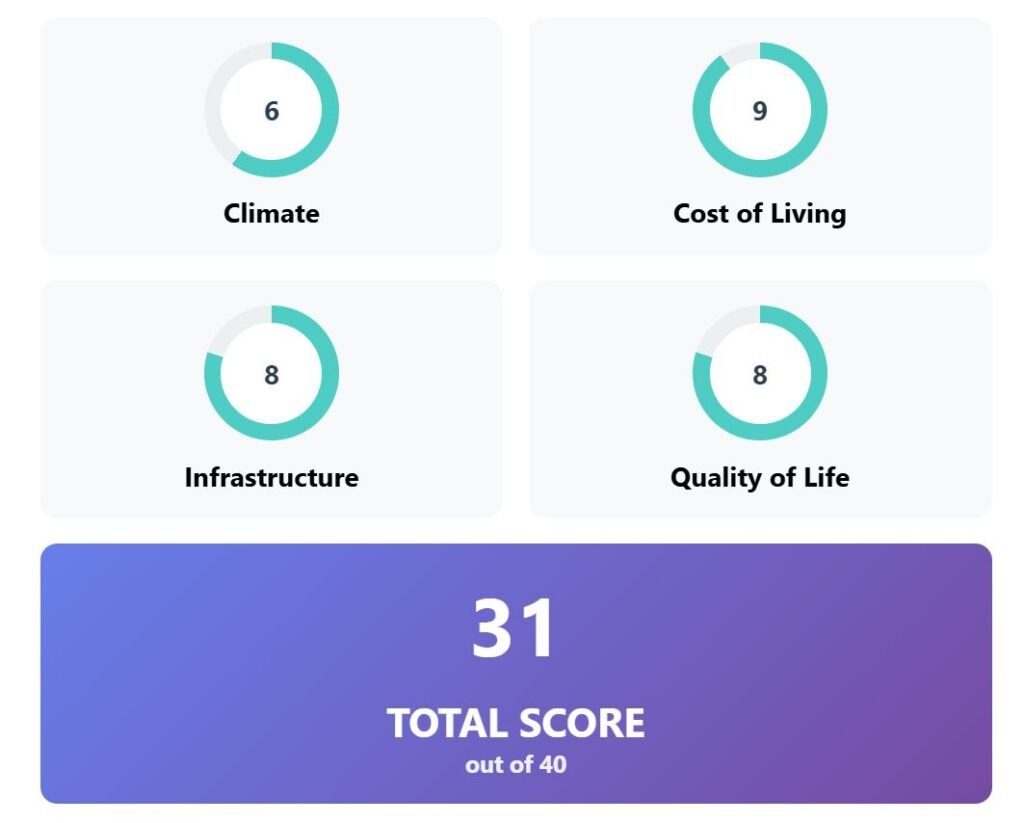
Altogether, Cluj-Napoca scores 31. From blustery Italy, the next city lies west in Portugal, where mild weather and affordability come together.
3 – Braga, Portugal
Braga, a city in northern Portugal with around 200,000 residents, often gets overshadowed by Lisbon or Porto, but it holds its ground with lower costs and a manageable climate.
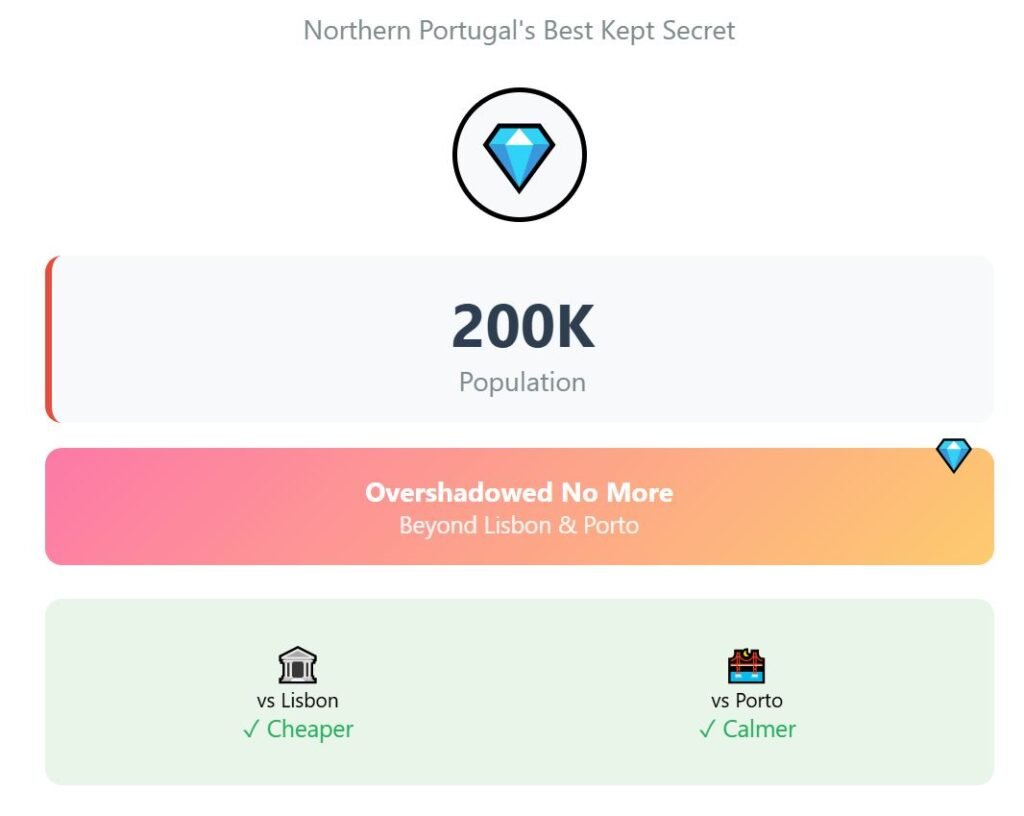
Summers are warm, but not too hot, usually peaking at 28–30°C, while winters are mild, wet, and rarely drop close to freezing. The balance avoids climate extremes, though frequent rain is a common complaint – but remember, our focus here is cooler weather, not hot cities, which I covered in another article. So for Braga, the climate score is an 8 out of 10.
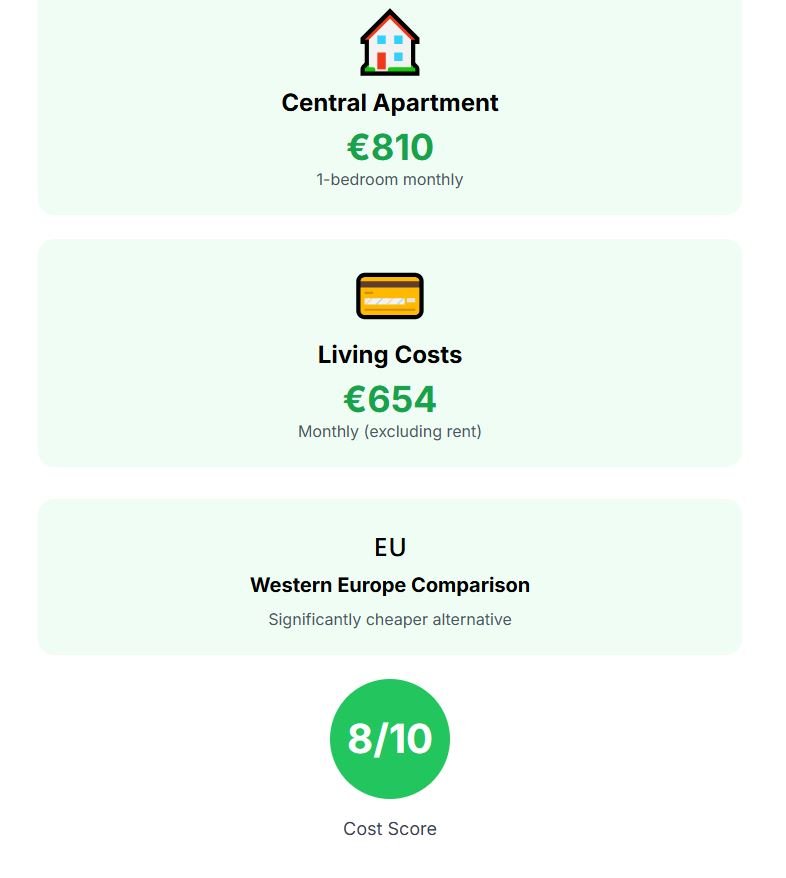
When it comes to expenses, Braga is among Portugal’s more affordable urban centers. A single person spends about €654 monthly on living costs excluding rent, while a central one-bedroom apartment averages €810. That makes it cheaper than much of Western Europe and even undercuts Lisbon by a good margin. Cost score: 8 out of 10.
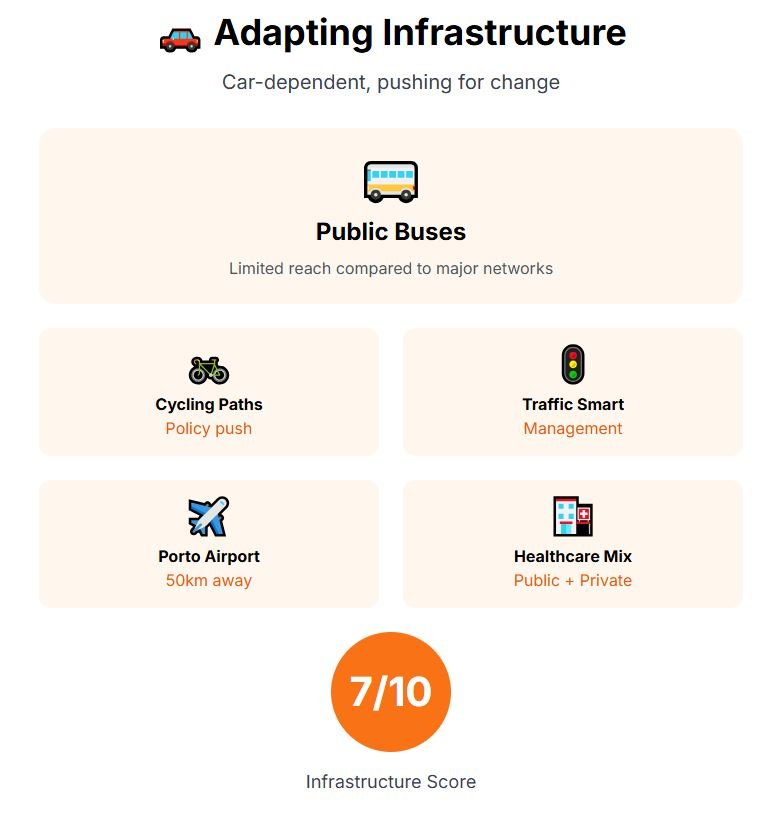
Infrastructure is still adapting. Most trips are made by car, but policies are pushing for cycling paths and smarter traffic management. Public buses serve the city but lack the reach of larger networks. By air, Porto’s international airport – just 50 kilometers away – provides full connectivity to European capitals. Healthcare combines Portugal’s universal public system with optional private insurance for faster service. Infrastructure score: 7 out of 10.
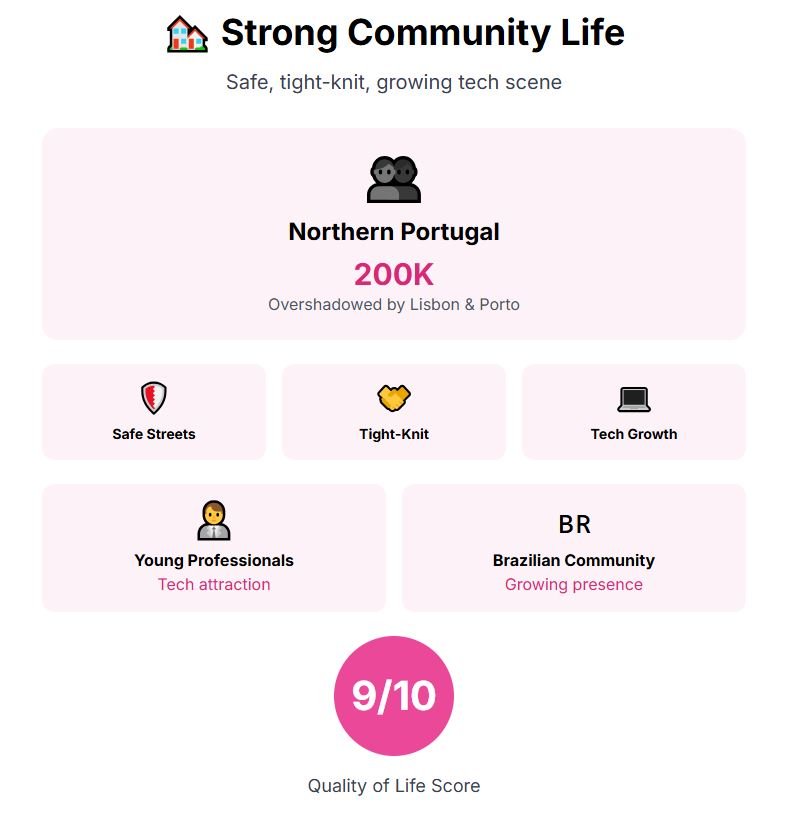
Quality of life remains strong. Braga has a safe atmosphere, a tight-knit community feel, and a growing tech scene that attracts younger professionals. If you don’t mind some rain (and an elevated number of Brazilians living in your vicinity), it is a really good city. Quality of life score: 9 out of 10.
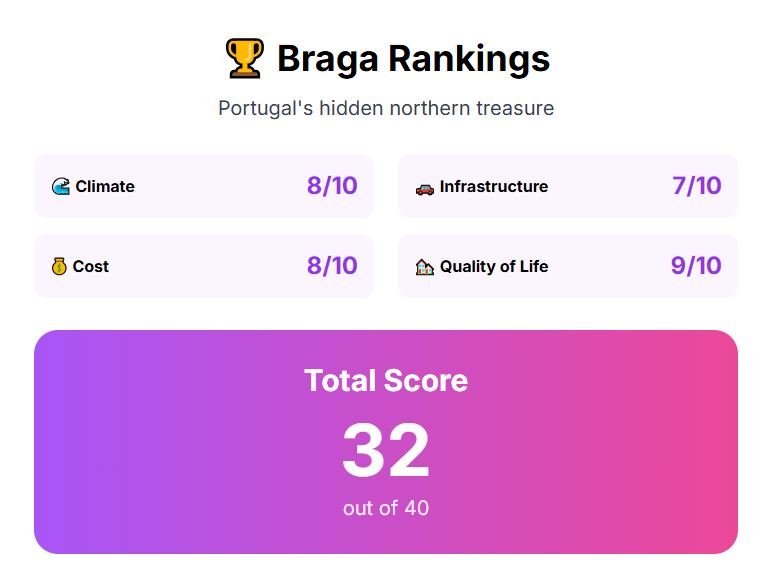
Altogether, Braga earns a total of 32 points. Now we head to Central Europe, to a new country with a polished capital.
2 – Ljubljana, Slovenia
The capital of Slovenia, has around 280,000 residents and it is right in the center of the country, surrounded by rivers and hills.

The climate brings warm summers with highs near 28°C and winters that often include snow, but air quality remains good because of strict traffic reductions in the city center. It is not mild every single day, but it manages seasons without severe extremes. If you don’t like Scorching weather, this is a really good city for you. For climate, Ljubljana earns a score of 8 out of 10.
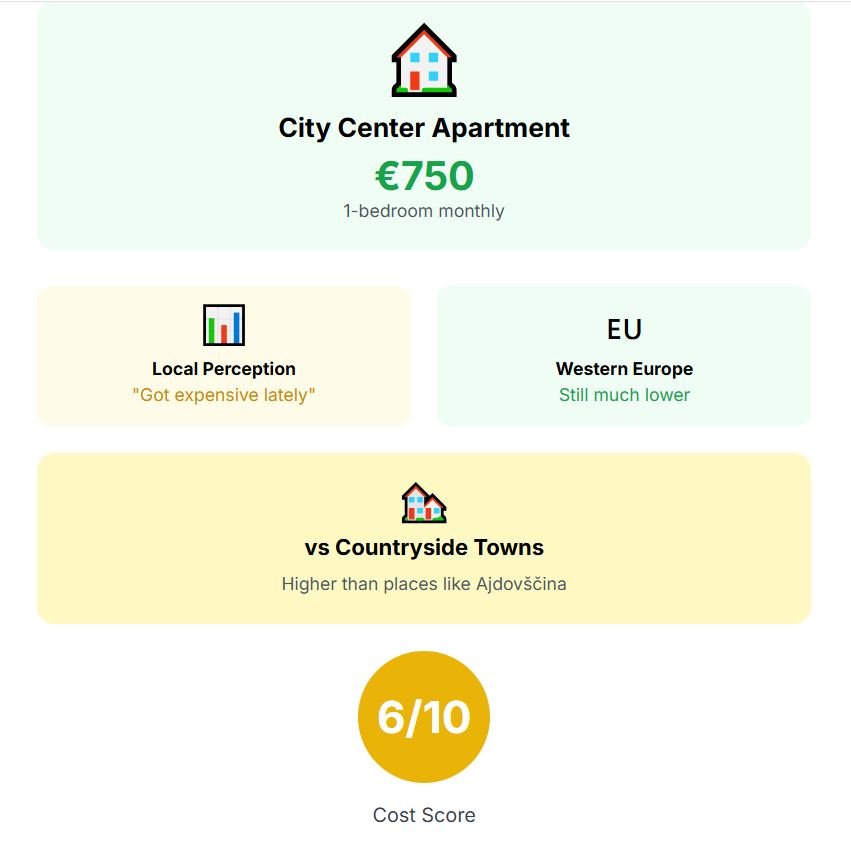
Costs are still much lower than in Western European capitals, albeit moving upward. You can find a 1-bedroom apartment for 750 euros per month. Locals often say that the Slovenian capital got expensive lately, and if you compare it to countryside towns like Ajdovščina, that is true. Due to its rising costs, Ljubljana gets just a 6 out of 10 in Cost of Living.
Infrastructure is one of the main advantages. During the time I spent in Ljubljana, I never felt the need for a car – I could do everything either by walking or by using public transport.

A strong bus network covers the city, and bicycles are widely encouraged through the expansion of cycle lanes. For longer trips, Ljubljana’s airport offers direct flights to several major capitals, and rail connections link to Vienna, Trieste, and Zagreb. There is public healthcare, but even if you prefer private healthcare, it is not expensive. Ljubljana has a very good infrastructure for a city with fewer than 300,000 residents, so it gets a 9 out of 10 in this factor.

Quality of life is high across multiple fronts. Safety is consistent, with very low crime rates, parks and green areas are easy to access, and community events keep residents engaged. The city is sometimes compared to a smaller, Central European version of Copenhagen for how livable it feels on a daily basis. Quality of life score: 9 out of 10.
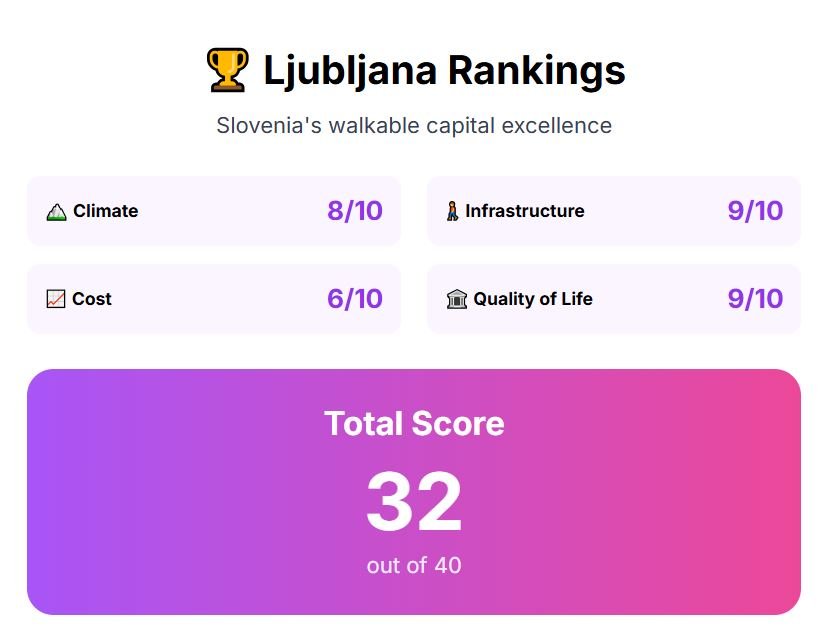
Adding everything together, Ljubljana receives a solid 32 points. Finally, we reach the city that ranked number one.
1st (and the Best Cool-Weather City in Europe to Live)
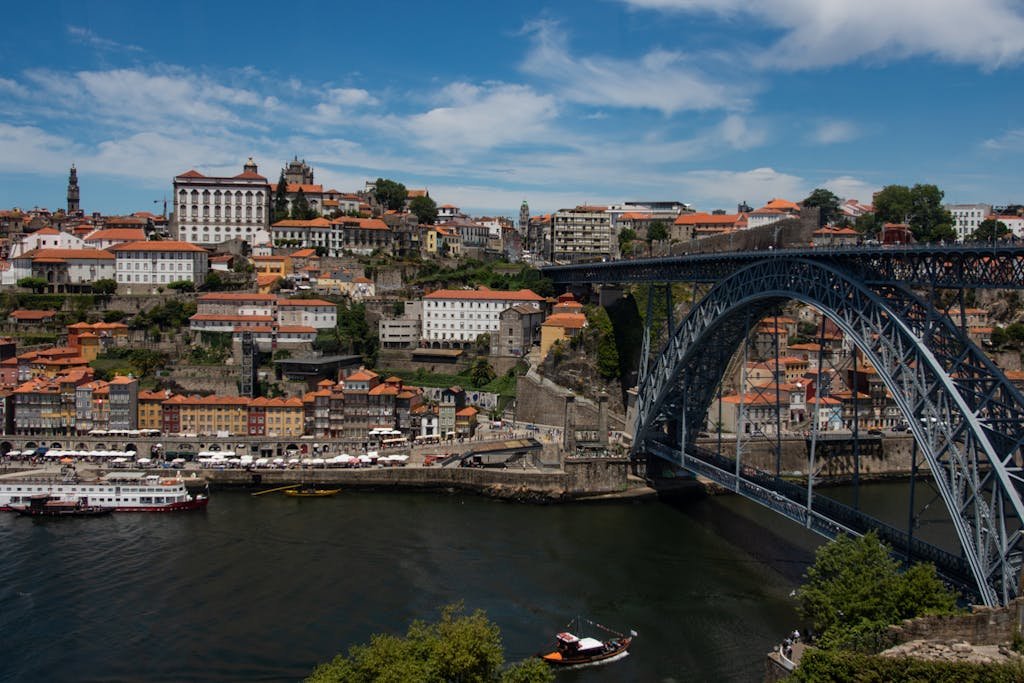
Porto is Portugal’s second-largest city, with about 230,000 people in the core and around 1.4 million across the metro area.
It is located on the Atlantic coast, where summers average 25°C and winters are rainy, but without the freezing conditions of northern Europe. This steady pattern avoids extremes while still giving seasonal variety. For climate (and for people who enjoy cool weather and refreshing rain), Porto scores 9 out of 10.
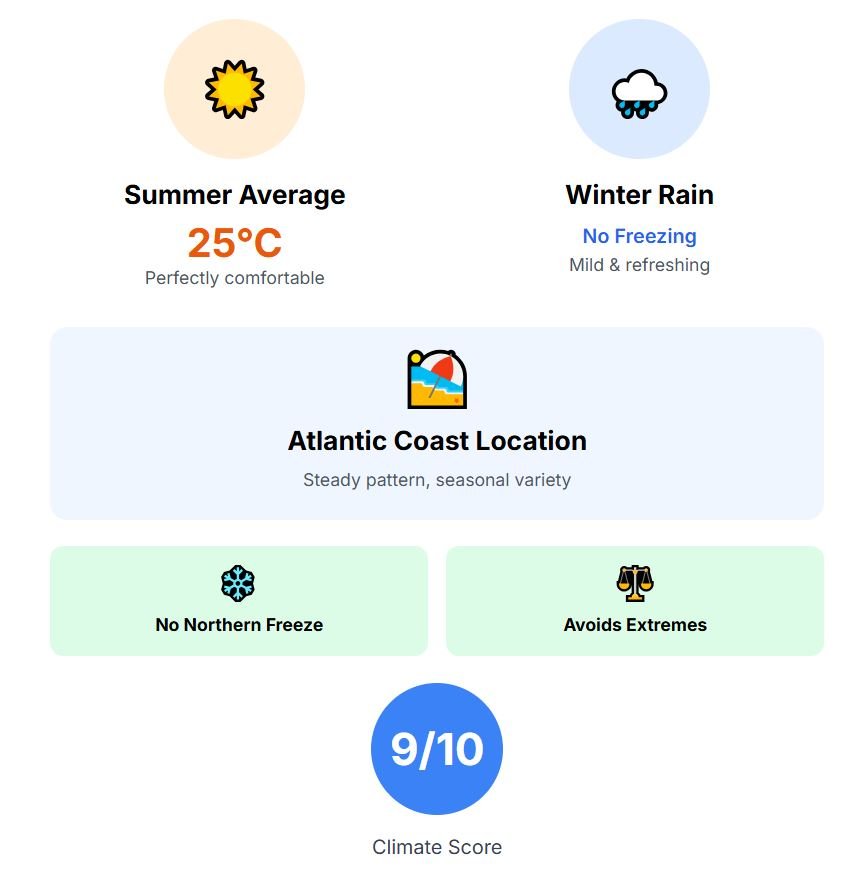
Living costs are moderate compared to Western Europe. A one-bedroom apartment rents for about €760 per month, while monthly expenses for a single person land near €750. These numbers make Porto more affordable than most French, German, or British cities, though slightly above Eastern European levels. For affordability, it receives 7 out of 10.
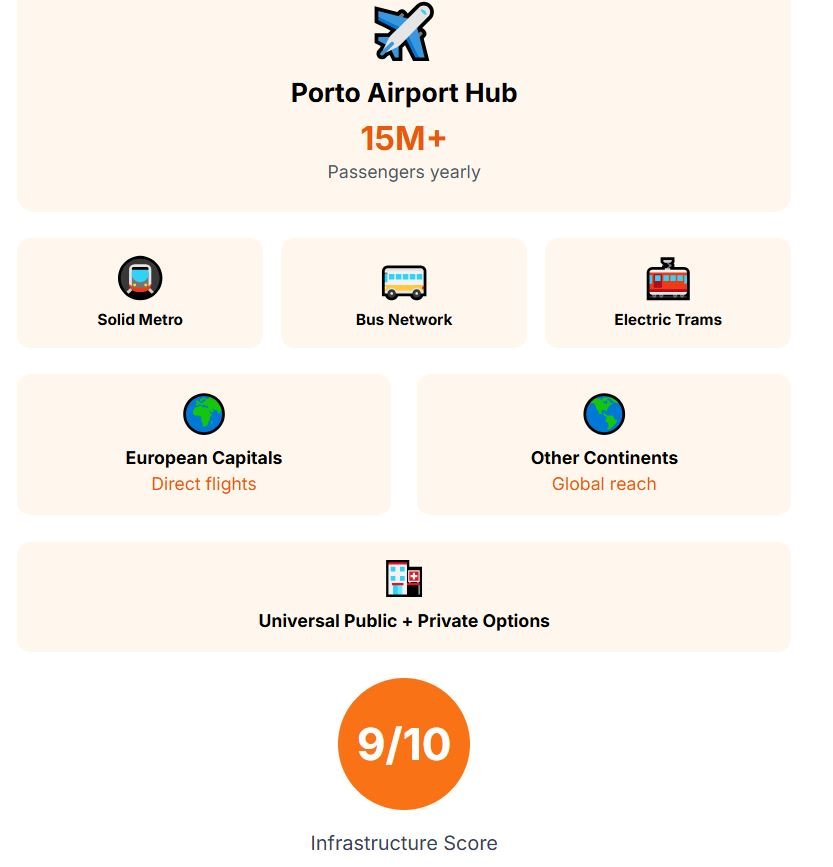
Infrastructure shows many strengths. The metro and bus network is solid, and the city runs electric trams in dense areas. The Porto airport connects directly to other major European capitals and even to other continents, and it serves over 15 million passengers every year. Healthcare functions under Portugal’s universal public system, but there are many options of private providers used for quicker access. Infrastructure score: 9 out of 10.
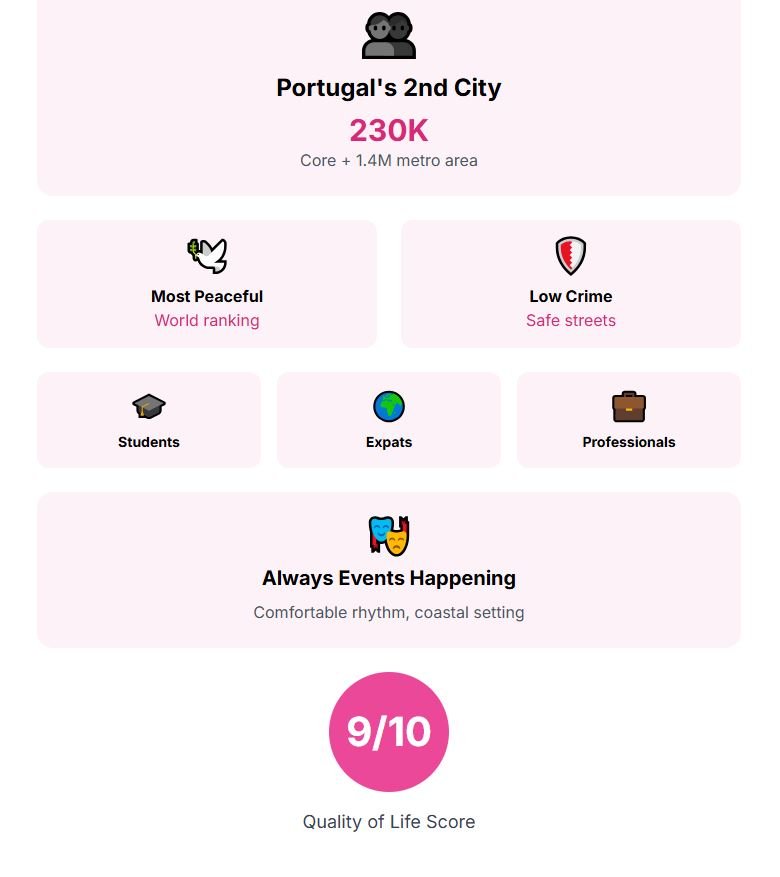
Quality of life completes the picture. Portugal consistently ranks among the most peaceful countries in the world, and crime rates in Porto are low. Porto has a huge population of students, expats, and young professionals, so there are always events happening. Combined with the coastal setting, the city’s rhythm remains comfortable without overwhelming scale. Quality of life in Porto scores 9 out of 10.
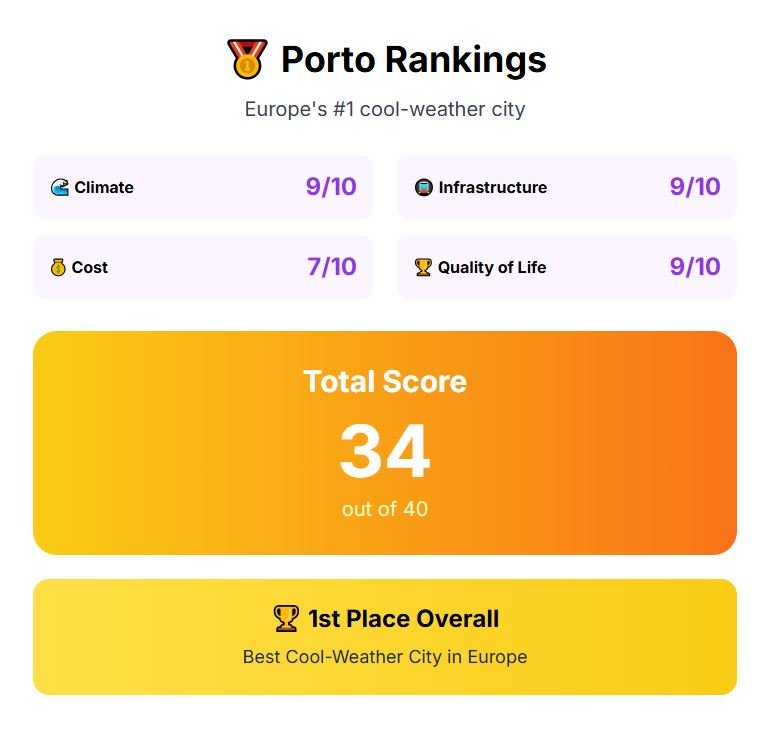
Adding all factors together, Porto totals 34 points. It combines a mild Atlantic climate, fair costs, a safe community, and reliable services, making it the top cool-weather city to live in Europe.
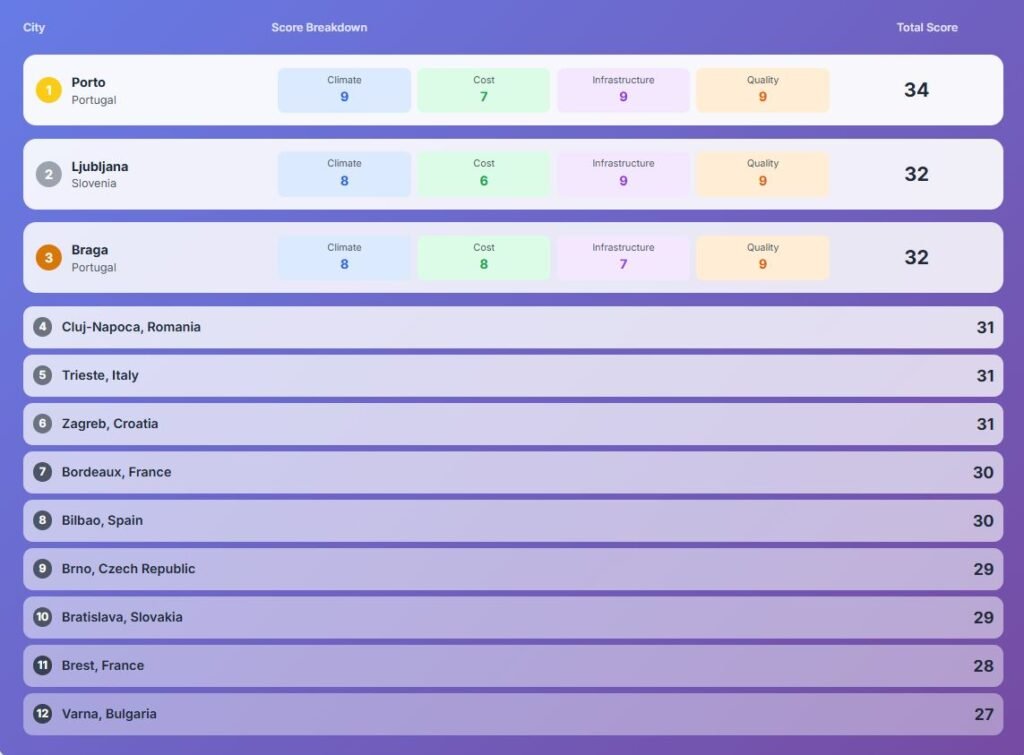
But what if instead of a city with 300,000 or 400,000 residents like those we mentioned today, you would prefer a smaller one, a town where life is slower, prices are even lower, and everything looks simpler?
For you, I ranked the best small cities and towns to live in Europe. These charming locations offer a perfect blend of scenic beauty, cultural richness, and a welcoming community atmosphere. They are not only ideal for young professionals and families, but are also some of the top European destinations for retirees seeking a relaxed and fulfilling lifestyle.
Levi Borba is the founder of expatriateconsultancy.com, creator of the channel The Expat, and best-selling author. You can find him on X here. Some of the links above might be affiliated links, meaning the author earns a small commission if you make a purchase.
